Content
- 1 Features of culture
- 2 Winter-hardy cherry varieties
- 3 Early varieties of cherries
- 4 Mid-season varieties
- 5 Mid-late varieties
- 6 Highly transportable varieties
- 7 Description and biological features
- 8 Beneficial features
- 9 Varieties grown in Ukraine and Russia
- 10 Agricultural engineering and planting
- 11 For the Northwest region
- 12 For Belarus
- 13 For Ukraine
- 14 Cherry varieties: description and photo
Among stone fruit species, sweet cherry is the most favorite crop of early ripening. The first fruits are harvested at the same time as strawberries. And with the correct selection of varieties, the period of consumption of fresh cherries can be continued until the end of July!
Features of culture
Sweet cherry is considered a southern crop, but if there are no strong temperature changes, especially at the end of winter, then its wood can withstand temperatures up to -29 ° C, and flower buds - up to -26 ° C.
Unlike cherry, sweet cherry is less damaged by moniliosis and coccomycosis, has more winter-hardy pollen, which explains the stable and annual yield of this crop. With the advent of winter-hardy varieties, cherries began to be grown in the northern regions of not only our country, but also abroad.

Winter-hardy cherry varieties
In recent years, varieties of Ukrainian selection with high winter hardiness and adaptability have been created. Such varieties are very popular also because the average weight of the fruit is 12-14 grams.
The best among them for the southern Steppe and Forest-steppe are: "Exhibition", "Elektra", "Delight", "Household", "Temporion", "Rival", "Legend Mliyeva", "Dar Mliyeva"; in the conditions of Donbass: "Valeria", "Yaroslavna", "Donetsk coal", "Vasilisa", "Donchanka", "Otrada", "Aelita"; in the zone of the northern forest-steppe and Polesye: "Homestead", "Kitaevskaya black", "Tenderness", "Lyubava", "Donchanka", "Vasilisa", "Annushka" and others.
When selecting varieties for a personal plot, it is important to consider where the variety was obtained and what are its features. So, if in the conditions of the Kiev region the varieties bred in this zone (for example, "Beauty of Kiev", "Kitaevskaya Black"), after the harsh winter of 2005-2006, bore fruit well, then of Western European origin ("Ven", "Blenkenburn", "Vega ») Were not only without a crop, but also with severe freezing of the lateral and skeletal branches. Therefore, when buying cherry seedlings, purchase only proven, environmentally sustainable varieties for each specific growing area.
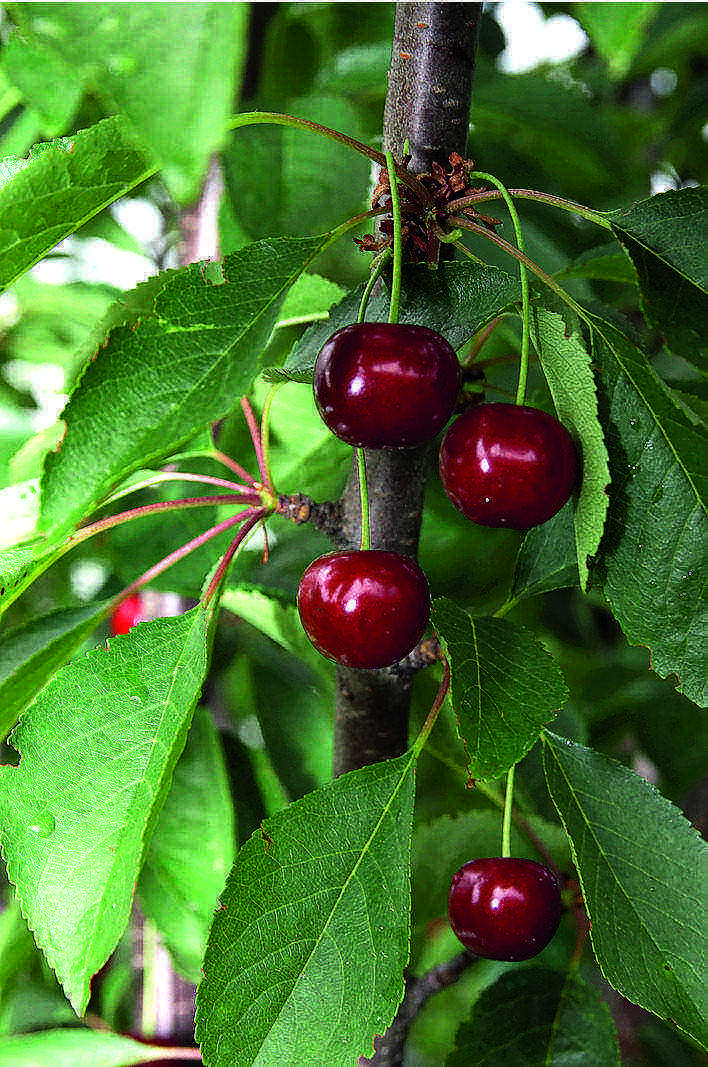
Early varieties of sweet cherries
Among the group of early varieties, the Priusadebnaya variety deserves respect. And although it was obtained in the south (at the Institute of Irrigated Horticulture, Melitopol), it nevertheless has a high winter hardiness and generous annual fruiting in the northern regions of Ukraine. It is especially appreciated for the high taste and marketability of fruits that have a light yellow color with a beautiful light red blush. In the same ripening group, the Valeria variety is interesting, but with a dark fruit color. The latter was obtained by crossing the most large-fruited variety "Valery Chkalov" and the winter-hardy "Donchanka". It ripens in the 1st decade of June.
Mid-season varieties
In the group of mid-season varieties, Vasilisa stands out for its large fruit size (average weight - 12-14 g) and high taste, and Yaroslavna stands out for its early maturity and yield. They were obtained at the Artemovskaya experimental nursery station. The most winter-hardy and highly productive variety for the northern forest-steppe and Polesye remains the Kitaevskaya Black variety in this group, its ripening occurs in the 2-3rd decade of June.
Since sweet cherry is a self-fertile culture, it is desirable to have 2-3 varieties on the site with approximately the same flowering time, which will ensure reliable cross-pollination. However, to get a good cherry harvest, it is not enough just to choose varieties; you need to know where to place the trees correctly and how to form the crown.
Elena Kischak, Head of the Laboratory of Technical Cultivation of Fruit Crops, Institute of Horticulture, UAAS
Mid-late varieties
Among the mid-late varieties should be noted with high transportability and disease resistance - "Tenderness", "Lyubava" and "Aelita". All of them have a yellow fruit color with a bright pink-red blush. Among the dark-colored varieties, some of the best are Annushka and Krupnoplodnaya. They ripen in the 3rd decade of June - 1st decade of July.
Highly transportable varieties
The most winter-hardy and highly transportable variety is "Sister". The harvested fruits can be stored at room temperature for about 2 weeks, and in the refrigerator for more than a month. Ripening occurs in the 1st – 2nd decade of July.
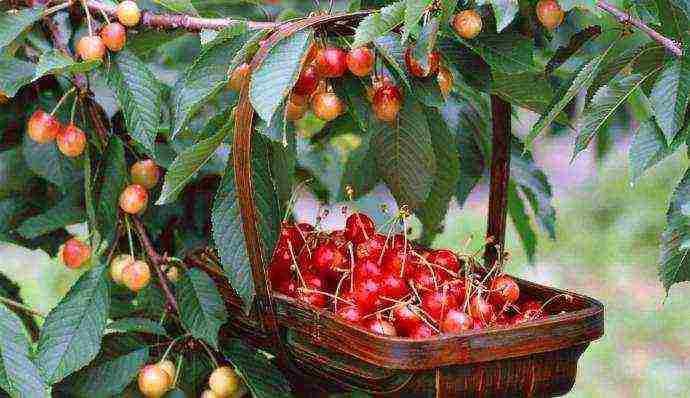
All varieties of cherries are close relatives of cherries (different types, but one genus, see Cherry). In the past, they were even considered as a single culture, and yet it differs from cherries in greater sweetness of the fruit, for which it is sometimes called "sweet cherry".
Sweet cherry is even more pronounced "southerner" than cherry, and goes beyond the European part of the continent only in Central Asia.
Description and biological features
The natural shape of the crown of cherries is from pyramidal to rounded. Like cherry, sweet cherry is distinguished by strong growth and even surpasses it in this indicator (wild cherries can reach a height of 25 m), while sweet cherries, unlike cherries, do not have pronounced bush-like forms, and their shoot-forming ability is weaker.
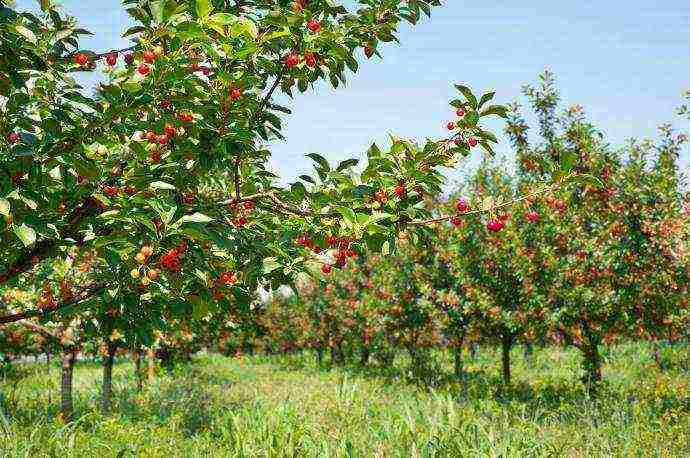
Generative buds are formed on strong annual shoots and on shortened bouquet branches, in which fruiting is concentrated, and they are located in the lower part of the growths (vegetative buds are located in the upper part). As a rule, cherries appear earlier than most varieties of cherries.
Sweet cherry is self-fertile, and pollinating varieties are required for its cultivation. It is not pollinated by cherries, but it can serve as its pollinator.
The main difference between cherries and cherries is their great thermophilicity, they absolutely cannot stand too low winter temperatures, otherwise the agricultural technology of cultivating these crops is very similar. The border of its industrial cultivation in the territory of the former USSR runs along the line Kaliningrad - Minsk - Chernigov - Kharkov - Rostov - Astrakhan and then descends to the Central Asian republics, however, in dacha and household farms, certain varieties are grown in the central regions of Russia.
Beneficial features
Cherries are prized primarily for their excellent taste, which are generally used in the same way as cherries. In terms of chemical composition, they are also very similar, with the only difference that the fruits of sweet cherries contain much more sugars (up to 18%), among which glucose is in the first place, and in the fruits of yellow-fruited varieties there is slightly less vitamin P.
Varieties grown in Ukraine and Russia
There are about 4000 varieties of sweet cherries in the world, of which 33 varieties have been zoned in Ukraine, including 18 new varieties of Soviet selection, 13 foreign varieties, and two local folk varieties. There are 46 varieties in Russia, of which more than half (26 varieties) are in the North Caucasus region.
According to the consistency of the pulp, all varieties of cherries are divided into two groups: bigarro and gini.
In bigarro cherries, the flesh is gristly, dense, sweet, and the juice is slightly colored or colorless. The best representatives of this group: Bigarro Daibera, Gedelfingen, Drogana yellow, Jabule, Napoleon pink, Franz Joseph, etc. Bigarro cherries are highly valued for the fact that they are not only good for fresh consumption, but also suitable for various types of canning (compotes, jam, etc.), since their pulp does not boil over.
Gini from bigarro are distinguished by tender, soft and sweet pulp. Their juice is weakly colored or not at all colored. Most of the earliest varieties belong to this group, but most of them are table varieties.
According to the ability to branching, cherry varieties are divided into weakly and strongly branching.
Varieties released in Ukraine
Badachonskaya black. A variety of Hungarian selection. Zoned in the Transcarpathian region. The tree is vigorous, the crown is sparse. Fruits are large (weight 6-7 g), broad-heart-shaped, dark red (almost black). The pulp is juicy, dense, dark red, sour-sweet, the taste is very good. The yield is average. The variety is very demanding on heat, low winter hardiness.
Bagration. The variety was bred in the Nikitsky Botanical Garden. Zoned in Ukraine in the Crimean region; outside the country - in Azerbaijan. The tree is vigorous, with a wide-pyramidal dense crown. Begins to bear fruit in the 4th-5th year. In size, the fruits are medium or larger than medium (weight 5-6.5 g), rounded, light yellow with a beautiful bright blush, firmly adhere to the tree. The pulp is light yellow, sometimes almost white, of very good taste. The juice is colorless. In Crimea, the fruits ripen in the 2-3rd decade of June. The variety has a high yield, the fruits are not affected by rot.
Bigarro Troll. The variety, like the previous one, is zoned in Ukraine in the Crimean region; outside the country - in Azerbaijan. The variety was named after the originator - this cherry was bred by Groll at the beginning of the 19th century. in Guben (Germany). The tree is tall, the crown is wide-oval, rare. Begins to bear fruit in the 5-7th year. The fruits are large (weight 6-7 g), broadly rounded, creamy with a pink blush, ripen from the second decade of July. The pulp is creamy, dense, juicy, sweet, of very good taste. Productivity and winter hardiness are average.
Bigarro Chernivtsi. A variety of Hungarian selection. Zoned in Ukraine in the Chernivtsi region. The tree is medium-sized, the crown is broad-pyramidal. Begins to bear fruit in the 6-7th year. Fruits are large (weighing up to 8 g), broad-hearted, dark red (almost black), ripen in late June - early July. The pulp is firm, dark red, sweet, with a slight sourness, the taste is rated as very good or excellent. The juice is dark red. The bone is small. The yield is low. Fruit transportability is good. The winter hardiness of the variety is average.
Valery Chkalov. The variety was bred on the basis of the Pink variety. Zoned in Ukraine in Dnepropetrovsk, Zaporozhye and Kirovograd regions. Tall tree. Begins to bear fruit in the 5-6th year. Fruits are large or very large (weight 7-9 g), round cordate, dark red, almost black at full maturity, ripen in the second decade of July (in the south of Ukraine - in the first decade of June). The pulp is dark red, sour-sweet, taste good. The juice is dark red. The yield is high. In the steppe and forest-steppe zones of Ukraine, the variety behaves as winter-hardy.
Gedelfingen. Zoned in Ukraine in Vinnytsia, Transcarpathian, Kirovograd, Lviv, Odessa, Ternopil, Khmelnytsky and Chernivtsi regions; outside Ukraine - in Russia in the Krasnodar Territory, the Kaliningrad Region and in Dagestan. Tall tree. Begins to bear fruit in the 4th-5th year. Fruits are large (weight 7-8.5 g), broad-hearted, dark red, almost black at full maturity, ripen at the end of June. The pulp is firm, dark red, sweet, very good taste. The juice is red.The variety is distinguished by its undemanding soil conditions; winter hardiness is sufficient only for the south of Ukraine and Transnistria.
Germersdorf. A variety of German breeding. Zoned in the Transcarpathian region. The trees are tall, the crown is pyramidal, dense. Begins to bear fruit in the 3-5th year. Fruits are large (weight 6-8 g), oblong-cordate, dark red, almost black at full maturity, ripen in mid-July. The pulp is light red, medium density, juicy, sweet and sour, good taste. The juice is dark red. The yield is high. Winter hardiness is sufficient for Transcarpathia. The disadvantage is that in a rainy summer, the fruits are severely cracked.
Gaucher. A variety of German selection, the name was given by the name of the originator N. Gaucher. Zoned in Ukraine in the Crimean region; outside its limits: in Russia - in the Krasnodar Territory, as well as in Dagestan and Turkmenistan. Tall tree. Fruits are large (weight 5-6 g), almost round, dark red, almost black ripen at the end of June, suitable for table and technical processing. The pulp is firm, very sweet. The yield is high. The variety is undemanding to the soil, moderately hardy.
Dyber is black. The variety was obtained in the Crimea from a random seedling. Zoned in Ukraine in Vinnytsia, Dnepropetrovsk, Zaporozhye, Ivano-Frankivsk, Kirovograd, Nikolaev, Odessa, Ternopil, Kherson, Khmelnytsky, and Chernivtsi regions; outside Ukraine - in the North Caucasus and Moldova. The tree is tall. Begins to bear fruit early. Fruits are large (weight 6-7 g), flattened heart-shaped, dark red, sometimes almost black, ripen in late June - early July, hold firmly on the tree, suitable for fresh consumption and for technical processing. The pulp is firm, very juicy, sweet with a slight sourness, the taste is rated as very good or excellent. The yield is high. The variety is undemanding to the soil, but not winter-hardy enough.
Dniprovka. The variety was bred at the Melitopol Experimental Gardening Station as a result of crossing the Denissen yellow and Zhabule varieties. Zoned in Ukraine in Luhansk and Donetsk regions. A variety of medium ripening. Tall tree. Begins to bear fruit in the 5-6th year. Fruits are larger than average or large (average weight 5-6 g, the largest - up to 8 g), round-ovoid, dark red, ripen in the second decade of July. The pulp is light red, juicy, with a harmonious combination of sweetness and acidity. The stone is medium in size, it separates well from the pulp. The yield is high. The variety is valuable for its drought resistance, winter hardiness is sufficient only for the south of Ukraine.
Drogana is yellow. A variety of German selection. The name was given by the name of the originator Drogan. Zoned in Ukraine in all regions, except for the Transcarpathian, Sumy and Chernigov; outside Ukraine - in the North Caucasus, Azerbaijan, Armenia, Belarus, Georgia, Kazakhstan, Kyrgyzstan, Latvia, Tajikistan, Turkmenistan and Uzbekistan. It is considered the most common variety of yellow cherry. Tall tree. Begins to bear fruit in the 3-4th year, then annually. The fruits are rather large (5-8 g), round-ovate, light yellow, ripen in the first decade of July, suitable for fresh consumption and technical processing. The pulp is creamy or light yellow, dense, juicy, with a pleasant taste. The yield is high. Fruit transportability is poor. The variety is undemanding to growing conditions, winter-hardy.
Zhabule. The variety was obtained from a random seedling in France and became the ancestor of many new varietal hybrids. Zoned in Ukraine in Vinnytsia, Dnepropetrovsk, Donetsk, Zaporozhye, Ivano-Frankivsk, Nikolaev, Odessa, Ternopil, Kherson, Khmelnytsky and Chernivtsi regions; outside Ukraine - in Russia, Dagestan, Georgia and Moldova. One of the most widespread varieties of sweet cherries. The tree is tall, the crown is round. Begins to bear fruit in the 4th year.Fruits are medium or large (weight 5-7 g), broadly oval, slightly ribbed, dark red, sometimes almost black, ripen in early June. The pulp is dark red, firm, sour-sweet, the taste is very good. Winter hardiness is sufficient only for the south of Ukraine and Transnistria.
Zaporizhzhya. The variety was bred at the Melitopol Experimental Gardening Station as a result of crossing Franz Joseph and Early Marks. Zoned in the Nikolaev region. The trees are tall or medium-sized. Fruits of medium size (weight 4.8-5.3 g), round-oval, bright red, shiny, ripen on average on June 10-15, in some years - in the first decade of this month. With abundant fruiting, the fruits become smaller. The pulp is light pink or red, juicy, with a pleasant wine-sweet taste. The stone is small, does not separate from the pulp. The yield is high. The variety is undemanding to soil and drought-resistant, winter hardiness is sufficient only for the conditions of the south of Ukraine.
Gold. The origin of the variety is unknown. Zoned in Ukraine in the Crimean region, in Moldova, Turkmenistan and Uzbekistan. The trees are tall. Fruits are large (weight 6-7 g), round, dark cream, begin to ripen from the second decade of July. The pulp is light creamy, dense, juicy, sweet, the taste is assessed as good. The juice is colorless. The yield is high. Winter hardiness is sufficient only for the southern regions.
June early. The variety was bred at the Melitopol Experimental Gardening Station from a French black cherry seedling. Zoned in Ukraine in Odessa and Kherson regions. The trees are vigorous, the crown is wide, almost round. Fruits are large (weight 7-8 g), broadly oval, dark red when fully ripe, shiny, ripen in mid-June, 3-5 days later than Zhabule. The pulp is light red, quite dense, juicy, wine-sweet, the taste is assessed as excellent. The yield is high.
Kiev woman. Zoned in Ukraine in Zhytomyr and Kiev regions. Tall tree. Begins to bear fruit in the 4th-5th year. The fruits are large (weight 5-6 g), round, pale amber-yellow with a beautiful pink blush, ripen in the second decade of July. The pulp is light creamy, medium density, juicy, sweet with a slight sourness, the taste is assessed as good. The yield is high. The transportability of the fruits is average. Winter hardiness is sufficient for the conditions of the Forest-steppe of Ukraine.
Kitaevskaya black. A variety of Ukrainian selection. Zoned in Ukraine in Zhytomyr and Kiev regions. Tall tree. At the time of fruiting, they begin in the 5-6th year, fruitful. Fruits are large (weight 5-7 g, individual up to 8 g), round-oval, dark red, almost black, ripen at the end of the second - beginning of the third decade of June. The pulp is dark red, rather dense, juicy, wine-sweet. Fruit transportability is good. Winter-hardy variety.
Beauty of Kiev. Variety of domestic selection, bred as a result of crossing Drogana yellow. Zoned in Ukraine in Zhytomyr and Kiev regions. Tall tree. Begins to bear fruit in the 6-7th year. Fruits are medium or larger than average (weight 5.3-6.6 g), round, light yellow with a pink blush, ripen in the second decade of June (Kiev). The pulp is white, juicy, sweet with a noticeable sourness. The yield is high. The variety is relatively winter hardy.
Beauty of the Crimea. The variety was bred in the Nikitsky Botanical Garden as a result of crossing the varieties Denissen yellow and Krasavitsa from Tuscany. Zoned in Crimea. The trees are vigorous, the crown is broadly oval, dense. Begins to bear fruit in the 4th-6th year. Fruits are medium or larger than average (weight 5-6 g), round-heart-shaped, light yellow with a reddish-pink blush, ripen in the second decade of June, do not crack on the tree. The pulp is light creamy, rather dense, juicy, sweet with sourness, the taste is rated as very good. The yield is high. Transportability is good. Drought-resistant variety.
Douka's favorite.The variety was bred at the Ukrainian Research Institute of Horticulture as a result of crossing the varieties Drogan yellow and Zhabule. Zoned in Ukraine in the Kiev region. The tree is vigorous, growing rapidly. Fruits are larger than average (weight 5-6 g), dark red, almost black at full maturity, begin to ripen from the second decade of June (Kiev). The pulp is burgundy, medium density, wine-sweet, the taste is assessed as very good. The yield is high. Transportability is good. The variety is winter-hardy enough for the conditions of the northern regions of the Forest-steppe.
Melitopol late. The variety was bred at the Melitopol Experimental Gardening Station. Zoned in Ukraine in the Nikolaev region. Tall tree. Fruits are medium or large (weight 5-7.5 g), heart-shaped, dark red, ripen in the third decade of July. The pulp is light or brownish-red, dense, juicy, sour-sweet, the taste is assessed as very good. The stone is small, easily separated from the pulp. The yield is high. Fruit transportability is good.
Melitopol black. The variety was bred at the Melitopol Experimental Gardening Station. Zoned in Ukraine in the Zaporozhye and Odessa regions and in the Crimea. Tall tree. Begins to bear fruit in the 10th year. The fruits are large (weight 6-8 g), round-oval, dark red or almost black, ripen at the end of the second decade of June. The pulp is dark red, dense, juicy, sweet with sourness. The juice is dark red. The stone is small, easily separated from the pulp.
Napoleon pink. An old German variety. Zoned in Ukraine in Vinnitsa, Zaporozhye, Kirovograd, Crimean, Lviv, Nikolaev, Odessa and Kherson regions; outside Ukraine - in the North Caucasus, Azerbaijan, Moldova, Tajikistan, Turkmenistan and Uzbekistan. Tall tree. Begins to bear fruit in the 3-4th year. Fruits are large, pale yellow with a bright pink or cherry-red blush, ripen in late June - early July; cracking is possible in rainy summer.
The pulp is white or creamy, firm, sweet with a slight sourness, the taste is assessed as very good. The stone is small, easily separated from the pulp. The juice is colorless. Productivity is high only in favorable conditions, without them - below average. The variety is very picky about growing conditions, it is strongly affected by fruit rot.
Nectar. The variety was bred at the Mleevskaya experimental gardening station from a seedling of the Napoleon white variety. Zoned in Ukraine in Vinnitsa, Kirovograd and Poltava regions. The tree is tall. Begins to bear fruit in the 4th-5th year. Fruits of medium size (average weight 5.5 g, some up to 7-8 g), dark red, shiny, ripen in the second decade of June. The pulp is dark red, juicy, tender, sweet with a slight sourness, the taste is assessed as very good. The juice is dark red, thick. Fruit transportability is good. The variety is winter-hardy enough for the forest-steppe of Ukraine.
Backyard. A variety of Ukrainian selection, obtained as a result of crossing the Denissena yellow and Zhabule varieties. Zoned in Ukraine in Vinnitsa, Dnepropetrovsk, Donetsk, Zaporozhye, Kirovograd, Crimean, Nikolaev, Odessa and Kherson regions. Tall tree. Begins to bear fruit in the 5-6th year. Fruits are large (average weight 6-7 g, individual - up to 8-10 g), rounded heart-shaped, light yellow with dark pink or red blush, ripen at the end of the first - beginning of the second decade of June. The pulp is colorless, tender, juicy, wine-sweet. The bone is easily separated from the pulp. The yield is high.
Pink Mleevskaya. The variety was bred in Ukraine from the seedling of the Drogana yellow variety. Zoned in the Zhytomyr region. The tree is medium-sized. Fruits are medium or large (weight 5-6 g), light yellow with a pink blush.
The pulp is yellow, dense, juicy, sweet and sour. The yield is high. Winter-hardy variety
Simferopol white. The variety was bred in the Nikitsky Botanical Garden as a result of crossing the varieties Golden and Black Eagle.Zoned in Ukraine in the Crimea, beyond its borders - in Azerbaijan. The tree is medium-sized. Begins to bear fruit in the 6-7th year, then - every year. Fruits are large (weight 6-8 g), light yellow, almost white without blush, ripen in the third decade of June (in the south of Crimea). The pulp is white, quite firm, medium-juicy, the taste is rated as very good. The juice is colorless. Drought-resistant variety.
Early ripening. The variety was bred at the Melitopol Experimental Gardening Station as a result of crossing Franz Joseph and Early Marks. Zoned in Ukraine in Dnepropetrovsk, Zaporozhye, Crimean, Nikolaev, Odessa and Kherson regions. The tree is medium-sized. Fruits are large (weight up to 9 g), dark red, ripen in late May - early June. The pulp is light red, juicy, wine-sweet. Productivity is high, bears fruit annually. Drought-resistant variety.
Tavrichanka. The variety was bred at the Melitopol Experimental Gardening Station as a result of crossing the varieties Franz Joseph and Wilhelmina. Zoned in the Odessa region. The trees are vigorous, the crown is narrow oval, rare. Fruits are large (weight 7-8 g), broad-hearted, dark red, ripen in the second decade of June. The pulp is red or dark red, moderately juicy, sweet with a slight sourness, the taste is assessed as excellent. The yield is average. Drought-resistant variety.
Franz Joseph. A variety of Czech selection. Zoned in Ukraine in Vinnitsa, Dnepropetrovsk, Donetsk, Zaporozhye, Ivano-Frankivsk, Kirovograd, Crimean, Lviv, Nikolaev, Odessa, Ternopil, Kherson, Khmelnitsky and Chernivtsi regions; outside Ukraine - in the North Caucasus, Turkmenistan and Uzbekistan. The tree is tall, the crown is narrow-pyramidal. Begins to bear fruit in the 4th-5th year, then annually. The fruits are large (weight 6-7 g), amber-yellow with a variegated blush, ripen in the third decade of June. The pulp is pinkish-yellow, tender, juicy, sour-sweet. The juice is colorless. Average winter hardiness.
Black Fromma. A variety of German breeding. Zoned in Ukraine in Volyn, Lvov, Rivne and Ternopil regions. Fruits are medium or large, blunt-heart-shaped, black-red, ripen in the second decade of July, in a rainy summer they can crack and / or rot. The pulp is dark red, tender, juicy, sweet with a slight sourness. The juice is dark red. Fruit transportability is good.
In Russia
In addition to Drogana yellow and Zhabule, the following varieties are most often cultivated:
Poetry. Fruits are yellow with a red blush, large. Resistant to coccomycosis.
Sinyavskaya. Fruits are dark-burgundy, large, high taste, average winter hardiness (freezing and cracking are possible).
Fatezh. Compact tree up to 3 m tall, fruits are large, pink. It has an unusual crown structure (shoots first grow up at a right angle, and then hang down beautifully).
Agricultural engineering and planting
Sweet cherry prefers loose, light fertile soils, clay soils are excluded. It is hygrophilous and more tolerant of many fruit trees refers to groundwater (permissible height - 1 m). Loves bright lighting, but does not wither in the shade (gives a lower yield).
Propagated by shoots and grafting.
You can inoculate the shoots by budding with an "eye". Several varieties of cherries with different ripening periods can be grafted onto one stock. In central Russia and north of it, cherries are recommended to be grafted onto cherries to increase frost resistance.
The recommended planting pit depth is 60-70 cm, diameter - 70 cm, the distance between trees is from Зх5 to 4х5m, depending on the variety, you can plant cherries in 1 row along the fence. If the planting was carried out in the fall, the trunks must be covered with earth.
Adult specimens are fertilized 2 times a season, starting from the second year after planting: first in the spring during digging, and the second time after flowering. Watering is carried out as needed (no more than two times per season).
The crown is usually formed sparsely tiered, less often - cupped (the general principle is like in cherries and plums). The basic general principles of crown formation: the length of the branches should decrease from bottom to top, and the angle of their departure from the trunk should increase; branches of the upper tiers should not be located directly above the branches of the lower ones (their displacement along the axis of the trunk is required).
Regulatory pruning should aim to prevent thickening. At the beginning of fruiting, annual branches longer than 50 cm are removed.
Other types of pruning are carried out as needed. In old trees, the top dries out. If this happens, the cherry requires a stronger anti-aging pruning, but fruiting after it will not recover immediately.
There is hardly a person who would not like cherries. Modern breeders are developing all new varieties with improved characteristics - more frost-resistant, with genetically "built-in" immunity, and so on. Cherries in the countries of the former USSR can now be grown not only in areas with a warm subtropical climate, but also in regions with relatively short summers and cold winters. The most difficult thing is to make a choice from the available variety. All other things being equal, preference is often given to self-fertile varieties. This allows you to save space in the garden, which is very important for the owners of the notorious "six acres".
For the Northwest region
The climate in the Northwest region of Russia is unpredictable. Summer there, as a rule, is not too hot and sunny, and winter can turn out to be moderately cold and abnormally frosty, moreover, with little snow. For cherries, such conditions are not optimal, therefore the main selection criterion is frost resistance.
Self-fertile varieties of cherries differ from ordinary ones in that they are able to tie a crop without the presence of pollinating trees nearby. Consequently, there is no need to plant several cherries at the same time on the garden plot, because the hope for those that grow with neighbors is far from always justified. This allows you to significantly save space, which is always in short supply. Most of the self-fertile varieties have appeared relatively recently, therefore, they are characterized by the presence of other advantages, for example, frost resistance, immunity to diseases typical of the culture, high yields, early maturity, and so on.
Backyard yellow
A relatively recent achievement of Russian breeders. The "parents" of the variety are Leningradskaya Krasnaya and Zolotaya Loshitskaya. Household yellow belongs to the category of early varieties. It is recommended by the State Register of the Russian Federation for cultivation in the Black Sea region, but practice shows that this cherry can withstand and successfully adapt to much more severe climatic and weather conditions.
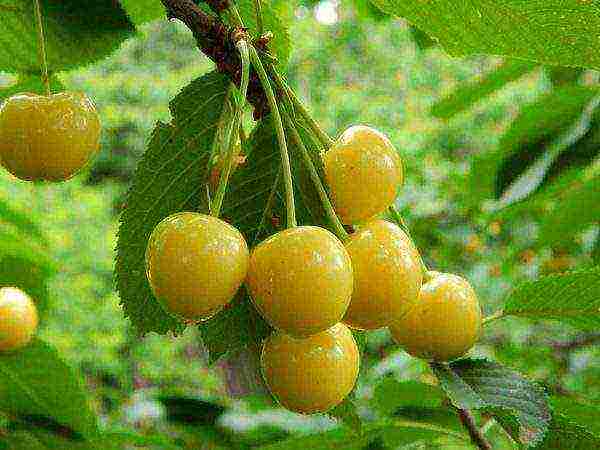
Sweet cherry Priusadebnaya yellow is a modern Russian variety, practically devoid of shortcomings
The sapling is distinguished by its growth rate, an adult tree is quite large, with a wide, almost spherical crown. At the same time, it is not very thickened, therefore, caring for the plant and harvesting is not particularly difficult. The tree blooms very beautifully, the flowers are large, snow-white, collected in inflorescences of three.
The berries are medium in size, round, weighing 5–6 g and about 2–2.2 cm in diameter. The lateral seam is not very pronounced. The skin, as you might guess from the name, is bright yellow, smooth. The subcutaneous points are completely absent. The pulp is lighter than the skin, the juice is almost colorless. The taste is sweet and sour, but very balanced. It is rated quite high by professional tasters - 4.7 points out of five. The stone is small, easily separated from the pulp.
The frost resistance of the tree is at the level of -30 ° C. Flower buds rarely suffer from recurrent spring frosts. The first fruiting is expected 5–6 years after the cherry is planted in the ground. Further, the harvests are annual.Even fully ripe berries do not crumble, they rarely crack in damp weather. The backyard yellow is bypassed by such a dangerous pest as a cherry fly.
Video: Home Garden yellow cherry
Bereket
The sweet cherry variety was bred in Dagestan by crossing the varieties of Drogan yellow and April black. The creators position the variety as self-fertile, but practice shows that it is more likely to speak from partial self-fertility. The state register of the Russian Federation advises to grow Bereket in the North Caucasus, but with frost resistance up to -30–32 ° C, the variety is quite suitable for the North-West region, other regions with temperate climates. The cold hardiness of flower buds is very high - 95–98%.
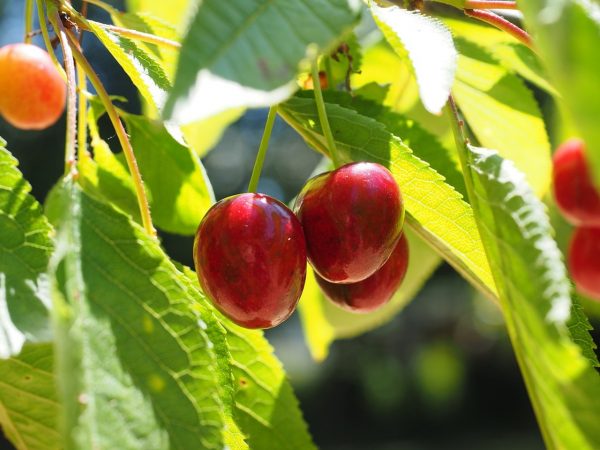
The flower buds of Bereket cherries are very frost-resistant.
Cherry Bereket medium early. When flowering in the last decade of April, it ripens in early or mid-July. The first harvest is tried 4–5 years after the tree has been planted.
An adult tree grows up to 5 m or a little more, differs in a spreading, rather "sloppy" thickened crown. Annual shoots are colored lilac green. The leaves are calyx-like, sagging slightly along the central vein.
The berries are medium in size, weighing 5.5–6.5 g and a little over 2 cm in diameter. The skin is dark scarlet, the flesh is pink-red. In it, veins are clearly distinguished, much lighter. Light acidity does not spoil the taste, which is rated by professional tasters at five points out of five possible. The stone is very small, weighing about 0.5 g. The berries are easily separated from the stalk, so mechanized harvesting is possible. In cool, damp weather, about one fruit in five will crack.
The average yield of Bereket cherries is 20–25 kg per adult tree. Berries are notable for good transportability. Fresh they can be stored for about a week. A significant drawback is the tendency to defeat moniliosis.
Goryanka
Another achievement of breeders working at the Dagestan Experimental Station. The "parents" of the Goryanka are French varieties of cherries Gaucher and Zhaboulet. When flowering at the end of the second decade of April, the harvest ripens in the first half of July.
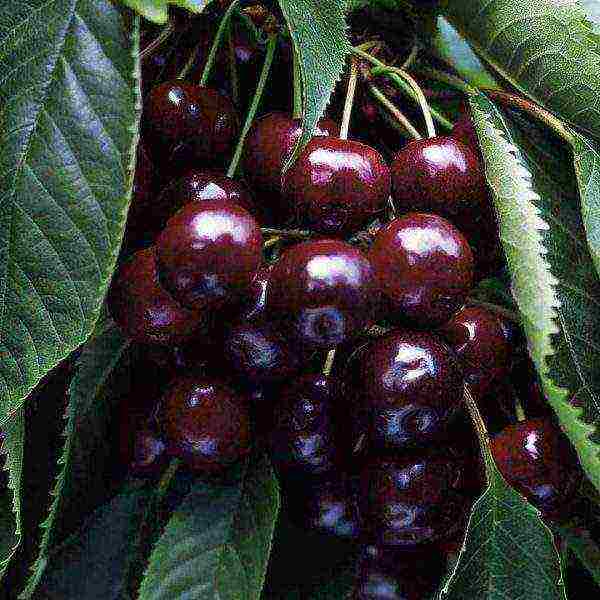
Cherry Goryanka belongs to varieties with a bouquet type of fruiting
The height of an adult tree is 3.5–4 m. The crown is densely leafy, in the form of a pyramid with a wide base. Nevertheless, practice shows that you can limit yourself to sanitary pruning. Annual shoots of lettuce color. The edges of the leaf are smooth, slight "serration" appears only closer to the tip. Flowers are small, collected in inflorescences in the shape of an umbrella, 5-7 pieces. The crop ripens exclusively on bouquet branches.
Heart-shaped berries with a rounded base. The side "seam" is practically absent. The average weight of one sweet cherry is 6–6.5 g. The skin is wine-burgundy, the pulp is intensely scarlet, the juice is of the same color. The taste is excellent, has earned a professional rating of 4.9 points out of five. The berries do not differ in transportability; fresh they can be stored for 5-6 days. The average yield is 18-22 kg per tree. The berries ripen at the same time. The first fruits will have to wait 4–5 years.
Frost resistance of Horny Goat Weed is at the level of -28–30 ° С, of flower buds - about 90%. Even open flowers rarely suffer from recurrent frosts. The variety tolerates short-term drought well, but with a prolonged moisture deficit, the tree practically stops growing, the shoots dry out and die off.
Dunn
One of the latest achievements of Russian breeders. The “parents” of the variety are the same as those of Priusadebnaya yellow, but the result of the crossing turned out to be completely different, although Danna also belongs to the category of early varieties. It got into the State Register in 1999 after zoning in the North Caucasus.
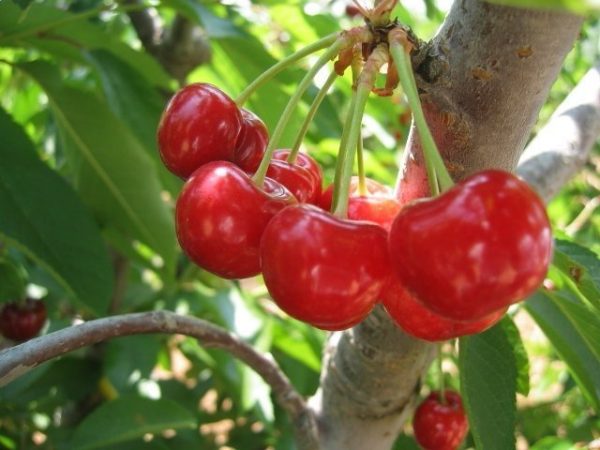
Danna is a promising Russian cherry variety; it is also interesting for those who grow berries on an industrial scale.
The tree is of medium height, about 4 m. The crown is in the form of a pyramid, quite rare. Shoots are reddish brown. The leaves are light lettuce, rather narrow and elongated for cherries. The buds are collected in inflorescences strictly in three.
The berries are medium-sized, weighing 4.5–5.5 g and 1.6–1.8 cm in diameter, but very sweet. The taste has earned a rating of 4.7 points out of five from the experts. The skin is deeply scarlet, monochromatic, smooth. The fruits are distinguished by a high content of vitamin C - more than 10 mg per 100 g. The lateral "seam" is poorly expressed.
Danna is characterized by resistance to adverse weather conditions - cold (up to -35 ° C), heat, drought. This sweet cherry rarely suffers from diseases typical of the culture, and is rarely affected by pests. For almost two decades of cultivation, no significant shortcomings have been found. Those who grow fruits and berries on an industrial scale are showing an increased interest in the variety. The first fruits will have to wait 5-6 years.
Pridonskaya
Another Russian sweet cherry variety, bred at the I.V. Michurin Research Institute as a result of crossing the Zolotaya Loshitskaya and Rannyaya Marka varieties. The fruits ripen at the beginning of the second decade of July. Pridonskaya is considered self-fertile, but practice shows that planting nearby varieties Revna, Iput has a positive effect on yield.
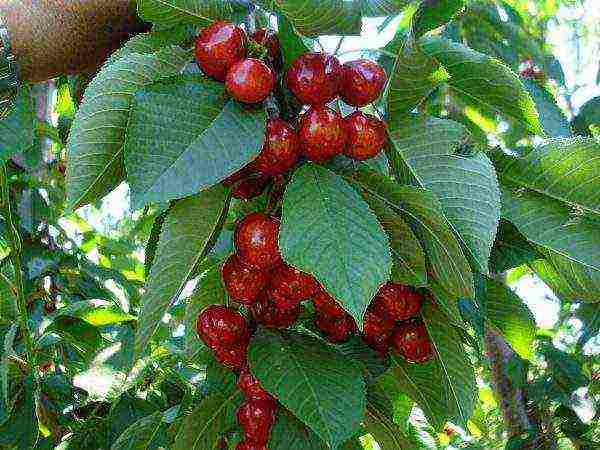
The cherry tree of the Pridonskaya variety is quite compact, it also does not differ in its growth rate
The tree is not tall (up to 3.5 m), the growth rate does not differ. Crohn is quite rare. Shoots are dark red, with an almost imperceptible brownish undertone, covered with well-distinguishable whitish lenticels. The buds are collected in inflorescences of three. More than 90% of the harvest ripens on bouquet branches.
The average weight of a berry is 5–6 g. They are one-dimensional, as if calibrated. They are easily separated from the stalks. The skin is blood-red, the flesh is pink-red (artists call this color scarlet), very juicy. Light "cartilages" are well discernible. The taste is sweet and sour, refreshing.
Pridonskaya has a high immunity against diseases typical for the culture, it is bypassed by most pests. The tree suffers little from heat and moisture deficit, in winter it tolerates frosts down to -25-28 ° C without much damage to itself. Flower buds are resistant to recurrent spring frosts.
The first harvest has to wait 6-7 years, then annual fruiting. Average yields are 20-25 kg per mature tree. The plant does not need formative pruning, it is quite enough sanitary. The variety is quite suitable for growing on an industrial scale. There are no significant shortcomings in the Pridonskaya cherry. Since 1999, when the culture was included in the State Register of the Russian Federation, it was not possible to identify them.
Valery Chkalov
One of the old well-deserved varieties, which has not lost its popularity to this day. This is a "natural" hybrid obtained as a result of spontaneous pollination of the Caucasian pink cherry. State trials began in the mid-50s of the last century, in 1974 the variety was recommended for cultivation in the North Caucasus, from where it gradually spread to territories with a temperate climate.
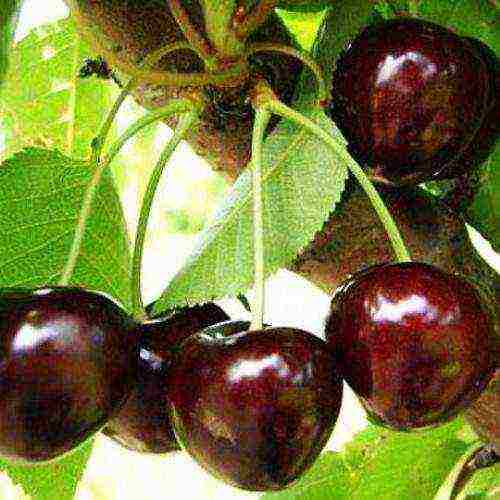
Cherry Valery Chkalov is one of the varieties that have successfully passed the test of time
The tree grows to 5.5–6 m in height and has a fairly dense pyramid-shaped crown. With age, it seems to "squat", the crown becomes more spreading. Shoots are grayish brown, powerful. They very often bend under their own weight or under the weight of the crop. The bark is rough to the touch. Leaves are ovoid, sharply tapering towards the tip. Flowering occurs in early April, fruiting in the first decade of July.
The berries are large, weighing 6–8 g, in the form of an almost regular ball or heart with smoothed outlines. The skin is painted in a very dark red color, from a distance the cherry appears black. The juice is rich scarlet. The stone is rather large, it is not too readily separated from the pulp. The taste is sour, but very pleasant. The content of vitamin C is almost a record - 21.5 mg per 100 g.
Fruiting begins five years after planting in the ground. The crop ripens annually. From an adult tree, depending on the growing region, you can remove from 60 to 150 kg of berries. Frost resistance up to -25ºС. A significant drawback is the tendency to attack by pathogenic fungi, especially those that cause gray rot and coccomycosis. Nevertheless, the tree is very hardy, capable of recovering even from serious damage.
The variety is considered partially self-fertile, the presence of cherries nearby Early Mark, Bigarro Burlat, Zhabule, Aprilka, Skorospelka contributes to an increase in yield. Valery Chkalov is one of the most popular types of cherries for breeders' experiments. With his participation, the varieties Valeria, Annushka, Farewell, Donetsk beauty and many others were bred.
Cherry variety Valery Chkalov
For Belarus
The climate of Belarus is in many ways similar to that characteristic of central Russia. Accordingly, varieties suitable for the North-West region can be successfully grown on the territory of this republic. Other, less frost-resistant Russian varieties of cherries are willingly planted there. The Belarusian breeders also have their own achievements, which are popular with fellow citizens.
Gorgeous
Sometimes found under the name Etok beauty. The variety has a consistently high yield. Bred in the Stavropol Territory by crossing the Denissen yellow and Dyber Black varieties. An essential advantage is absolute resistance to coccomycosis.

Cherry Beauty, indeed, looks very presentable
The variety is partially self-fertile. To increase the yield, the cherries of Diber, Golubushka, Franz Joseph, Narodnaya are planted nearby. Due to late flowering, the Beauty almost never falls under returnable spring frosts.
The tree reaches a height of 3.5–4 m, the growth rate does not differ. The crown is spreading, pyramidal or almost spherical. There are relatively few shoots, they are located in relation to the trunk at an angle of about 50º. The surface of the leaf is slightly wrinkled. Most of the crop ripens on bouquet branches at the age of 2–5 years.
The average weight of a heart-shaped berry is 8-9 g. Fruits are slightly flattened. The seam is almost invisible. The skin is bright yellow with a golden sheen. The pulp is yellowish, very juicy and sweet. The juice is almost colorless. The stone is not large, it is separated from the pulp without effort. The harvest ripens in the first decade of July. The fruit is characterized by very good transportability.
The variety is fast-growing, the tree bears fruit for the first time 3-4 years after planting in the ground. About 40 kg of berries are removed from plants under the age of 10, by the age of 15 this figure doubles.
Ovstuzhenka
The variety was bred in 2001 by one of the most famous breeders in this area - M.V. Kanshina. In Russia, the State Register is recommended for cultivation in the Central Region. Ovstuzhenka is considered self-fertile, but the presence of pollinating varieties is still recommended - Revna, Tyutchevka, Pink Pearl, Bryansk Pink.
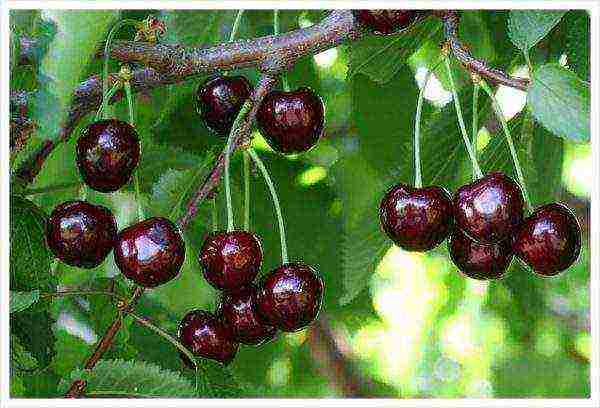
Winter hardiness of cherries of the Ovstuzhenka variety allows them to be grown in regions with any climate, with the exception of the subarctic
The tree is distinguished by its growth rate, so it reaches its “ceiling” of 3–3.5 m by the fourth year of its life. After the first fruiting, it grows mainly in width. His crown is not too thickened, almost spherical. The flowers are large, collected in inflorescences of three. Snow-white petals are overlapped. Flowering occurs in early April.
Most of the fruits weigh 4–4.5 g, but there are also “champions” weighing 7–7.5 g. The berries are round or slightly elongated. The skin is very dark with a purple tint. From a distance, the berries appear almost black. The pulp is not too firm, but very juicy, bright red. The stone is small, easily separated from it. Sweet and sour taste is rated 4.5 out of five.
The berries ripen in late June or early July.The first fruiting will have to wait 4–5 years. Young trees bring 15–20 kg of berries, then the yield increases to 30–35 kg.
Ostuzhenka has a very high frost resistance of wood (up to -45 ° C), and somewhat less - of flower buds. Also, the first almost never gets sunburn in winter. Up to 15% of buds can suffer from return frosts in spring. She never suffers from moniliosis and coccomycosis, but can become infected with clotterosporia.
Narodnaya Syubarova
The main distinguishing feature of this Belarusian variety is a very powerful tree. It grows up to 5-6 m in height, the crown is extremely wide. Accordingly, she is not afraid of any, even the strongest, winds; branches rarely break under the weight of snow. Also, the variety is valued for its undemanding quality of the substrate.
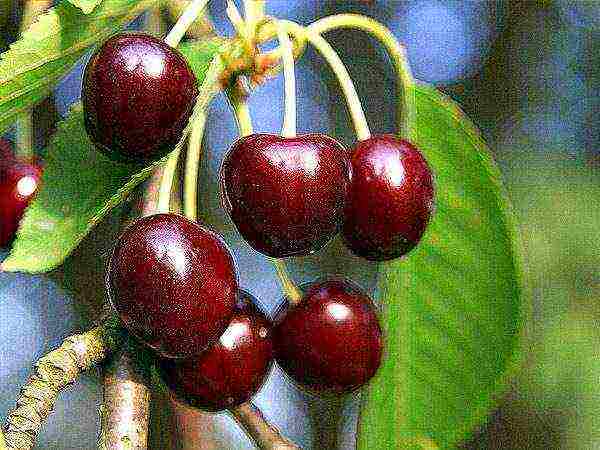
Cherry variety Narodnaya Syubarova is distinguished by its general unpretentiousness and undemanding to the quality of the substrate
The fruits are dark scarlet, the skin is glossy. The average weight of a berry is 5.5–6 g. The yield is at the level of 50–55 kg per mature tree. The first fruits are removed 4 years after the tree is planted in the garden. Cherry ripens en masse, in the middle of the second decade of July. Fruiting is annual.
The variety has an "innate" immunity to coccomycosis, rarely suffers from other fungal diseases. Self-pollination at the level of 90%.
Gastinets
Sometimes the spelling "Gastsinets" is found. One of the most popular Belarusian varieties. "Parents" - Red dense and Aelita. Belongs to the category of medium early (ripens in mid-July) and partially self-fertile. To increase yields, Narodnaya, Zhurba can be planted nearby.
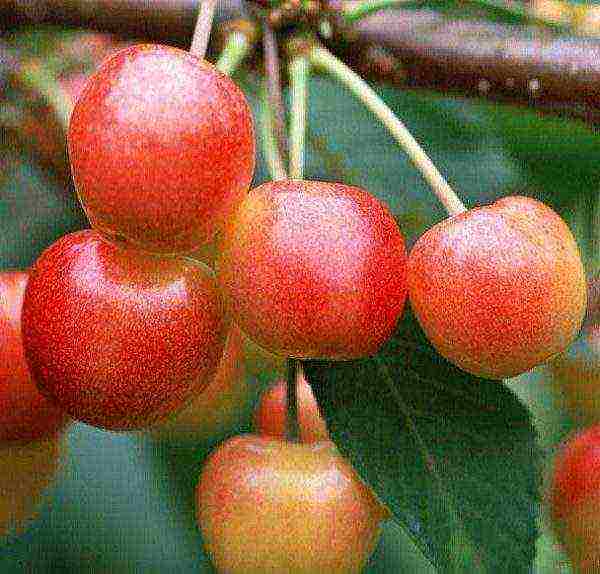
A significant advantage of Gastinets cherry is its resistance to coccomycosis
Winter hardiness at the level of -25 ° C. The tree bears fruit annually. The variety has an "innate" immunity to coccomycosis. Differs in early maturity. The first berries are tried three years after planting.
The fruits are large, heart-shaped, weighing about 7 g. The skin is bright yellow, the blush where the sun hits it is crimson or raspberry. The pulp and juice are almost the same color as the skin.
Tyutchevka
A popular Russian late cherry variety, bred at the beginning of the 21st century on the basis of the Red dense variety and a hybrid with the code name 3–36. In the Russian Federation, the State Register is recommended for cultivation in the Central Region, respectively, and for Belarus it is quite suitable. Due to partial self-fertility, it is recommended to plant pollinators (Revna, Iput, Raditsa).
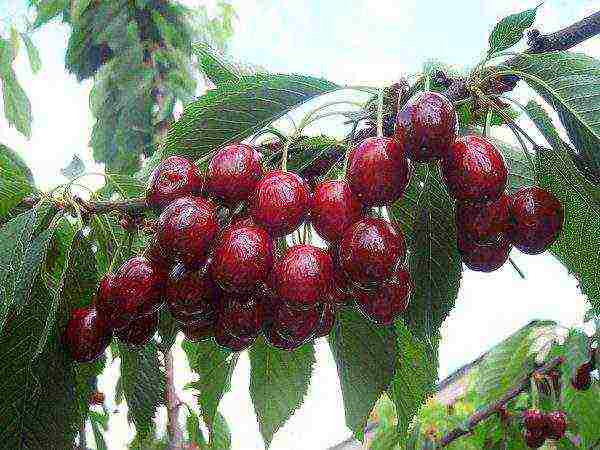
Cherry Tyutchevka is not devoid of significant shortcomings, but this does not affect its popularity in any way.
The tree is relatively low, up to 4 m. It reaches its maximum size already 4–5 years after planting. The crown is in the form of a ball, sparse. Leaves with very short petioles. The buds are collected in inflorescences of four. Approximately 85% of the fruits ripen on bouquet branches.
Berries weighing 5–7.5 g, dark scarlet with lighter subcutaneous dots. The stone is small, reluctantly separates from the pulp. Fruits are sweet, but "cartilage" is clearly felt in the pulp. Nevertheless, the taste is rated 4.9 out of five. The harvest ripens in the first decade of August. 18-25 kg of berries are removed from a mature tree. The first fruiting is five years after planting.
Among the disadvantages of the variety are berries that crack in rainy summers and the low winter hardiness of flower buds. More than 70% of future buds can suffer from recurrent frost. There is also a tendency to defeat coccomycosis and clasterosporiosis.
In memory of Astakhov
Another late cherry variety, ripening closer to mid-August. The tree is 4–4.5 m high, with a rounded, not too thickened crown. Differs in growth rate. The bark is grayish, highly flaky; after the leaves fall, it acquires a silvery hue.
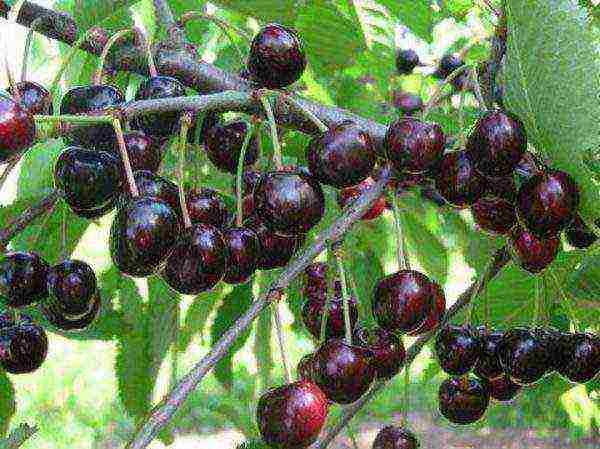
Cherry in Memory of Astakhov belongs to varieties of late ripening
The fruits are very presentable - one-dimensional, large (8 g or more). Deep burgundy berries.The stone is small, it separates well from the pulp. The skin is thin, smooth. The berry flavor is rated 4.8 out of five. Average yield is about 30 kg per tree.
The variety is rarely affected by diseases typical for the culture, its winter hardiness is at the level of -25-28 ° C. The berries ripen 5–6 years after the seedling is planted.
For Ukraine
The climate in most of the territory of Ukraine is much milder than in Russia and Belarus. Accordingly, local gardeners can afford to choose a cherry variety, focusing not only on winter hardiness, but also on the size, taste of the fruit, and yield. Recently, varieties from Europe and North America, which are grown in their homeland on an industrial scale, are gaining more and more popularity.
Annushka
A popular Ukrainian variety obtained with the participation of Donchanka cherries and Valery Chkalov. In Russia, he also received recognition, in 2000 he got into the State Register. It is recommended for cultivation only in the North Caucasus and the Black Sea region, but its high (-32–35 ° C) winter hardiness allows it to be grown in temperate climates.
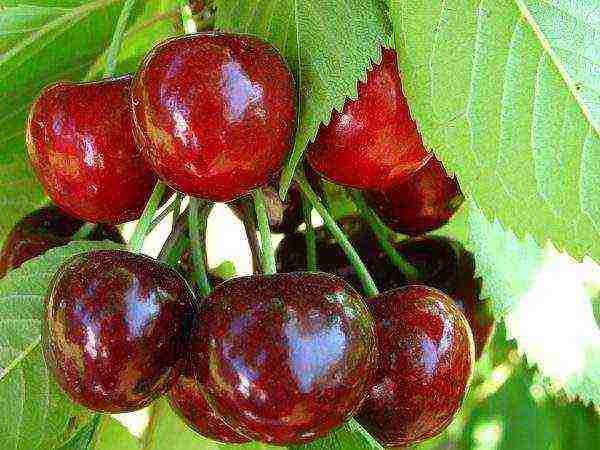
A flowering cherry tree of the Annushka variety looks very unusual
The tree is of medium height, 4–4.5 m. The crown is not particularly thickened. The shoots are thick. The buds are collected in inflorescences of 3-4 pieces. Flowers open before leaves appear.
Annushka is distinguished by presentability and large (9–10 g) berries. Deep scarlet skin. The pulp is slightly lighter, very sweet and juicy. At the same time, it is quite dense, which provides good transportability. Fruits are round, slightly flattened towards the base. Average yield is 20-22 kg.
The taste of the berries is little influenced by the way summer turns out. Annushka rarely suffers from drought, disease (with the exception of coccomycosis) and pests. The tree brings its first harvest in 3-4 years. For 10-12 years of fruiting, there is one "rest" season. This cherry variety requires careful site selection, being particularly sensitive to excessive soil moisture due to groundwater close to it. The tree grows quickly, so it needs regular pruning.
Tenderness
An old well-deserved variety, bred in the 60s of the last century in Kiev on the basis of Drogan yellow and Francis cherries. Differs in winter hardiness up to -30 ° C, belongs to the category of mid-season. The harvest ripens in late June. Because of this, it is not affected by the cherry fly - adults simply do not have time to lay eggs. The tree is up to 3 m high, the crown seems to be flattened, in the form of a wide oval.

Cherry fruits of the Tenderness variety are very sensitive to any mechanical stress
The fruits are very presentable - golden yellow with a bright crimson blush, one-dimensional, weighing 6.5-7 g. But you need to remove them from the tree very carefully - even from the lightest pressing on the skin, ugly brown spots blur. The "seam" is clearly visible. The pulp is pale yellow, its taste is pleasant, sweet and sour. Tasting score - 4.7 points out of five.
The first time Tenderness bears fruit 6 years after planting. 50-60 kg of berries are removed from an adult plant. Moreover, the more fruits, the smaller they are. To increase the yield (although the variety is formally self-fertile), Drogana, Nectarnaya, Kitaevskaya black are planted next to Tenderness.
Video: what sweet cherry looks like Tenderness
Backyard
One of the earliest varieties of sweet cherries. The fruits ripen in the first decade of June. The berries are one-dimensional, the skin is pale yellow with a vague pinkish "blush". The pulp is light, creamy. The yield is extremely high (80 kg or more). Some amateur gardeners even consider this a disadvantage. Fresh fruits are stored for a very short time and do not differ in transportability. Accordingly, you need to eat or process berries in record time. Taste qualities are rated highly - by 4.8 points out of five possible.

Unfortunately, the shelf life of Home Garden cherries is very short.
The fruits do not crack, even if heavy rains fall during their ripening. The first time a sweet cherry ripens 3-5 years after planting a seedling. The tree is of medium height (3.5–4.5 m), the crown is rather sparse, but spreading. The average weight of the berry is 5-6 g.
Planting nearby cherries Valery Chkalov, Skorospelki, Bigarro Burlat helps to increase the yield of a partially self-fertile variety. Frost resistance is quite sufficient for growing in most of the territory of Ukraine. The tree is rarely affected by moniliosis, coccomycosis, "black cancer". Due to the early maturity, the cherry fly does not have time to lay eggs in the fruit ovaries.
Valeria
One of the most successful of the many varieties bred with the participation of cherries Valery Chkalov. His homeland is Ukraine, where he is grown everywhere. Valeria is distinguished by its large-fruited and excellent taste of berries. Another significant plus is resistance to infection by pathogenic fungi and pest attacks. The variety is partially self-fertile.

Valeria is one of the many varieties bred with the participation of cherries Valery Chkalov
The tree is vigorous, the crown is rather dense, almost spherical. Valeria blooms late, therefore, it is guaranteed that it does not fall under return spring frosts, although in most of the territory of Ukraine this is a rather rare phenomenon.
The average weight of a heart-shaped berry is 9–10 g. The skin is dark-burgundy, the flesh is slightly lighter. The pulp is soft, not very dense, juicy. To increase productivity, it is desirable to have pollinators - Donchanka, Annushka, Lesya, Ugolyok. Ethics is categorically not suitable in this capacity. Fruiting is annual, an adult tree bears 30-50 kg of berries.
Lapins
Canadian cherry, bred on the basis of the popular varieties of Van and Stella in their homeland. Belongs to the category of late, the harvest ripens in the last decade of July or early August. Lapins is a completely self-fertile variety, practice shows that in the absence of pollinators, as many berries are tied as in the presence of them.
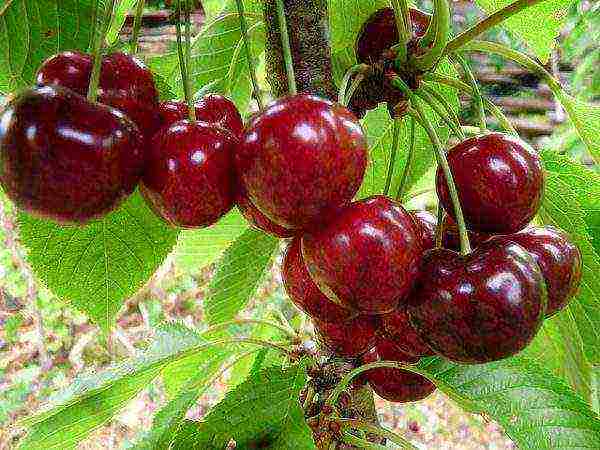
Sweet cherry variety Lapins has every right to be called self-fertile
The fruits are very large, weighing 10 g or more. The shape is round or oval, slightly flattened at the stalk. The skin is colored red, sometimes with a noticeable orange undertone, the flesh is pink-scarlet, dense. The palatability is excellent, estimated at 4.8 points.
The variety does not differ in frost resistance, it also suffers from prolonged droughts. If the summer is rainy, it is more than likely the development of rot and moniliosis, cracking of the berries. There is "innate" immunity from clasterosporia and coccomycosis.
The tree is tall, but it forms new shoots rather reluctantly. Formation of the crown will require considerable effort from the gardener. You can make your task a little easier by grafting Lapins onto a dwarf stock.
Even perfectly ripe berries do not fall from the tree. The variety is distinguished by good transportability; cherries can be stored in a refrigerator or under similar conditions for up to two weeks.
Dolores
The variety is of medium ripening, the fruits are harvested in the second decade of June. Bred in Dagestan. “Parents” - Napoleon black cherry and Lyubskaya cherry. The height of the tree is about 3.5 m, the crown is spreading, dense. But it does not need formative pruning, it is quite sanitary.
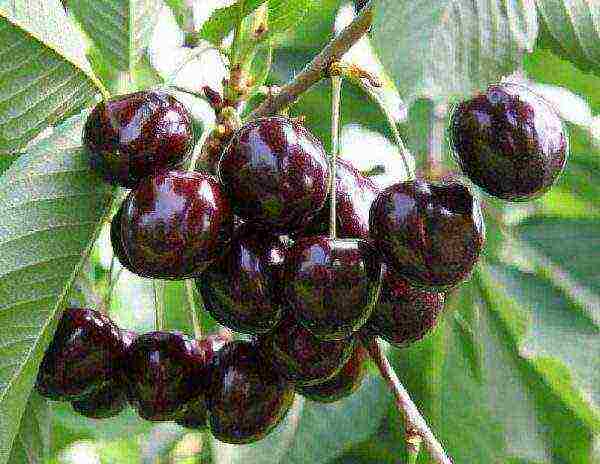
The taste qualities of Dolores cherries are rated as high as possible.
The berries are medium in size (weighing about 6 g), round in shape with pronounced "shoulders" and a side seam. The skin is rather thin, purple-violet, almost black with dark scarlet specks. The pulp is bright red, juicy, literally melts in your mouth. The taste has earned the highest possible assessment from the tasters.
Wood and flower buds are characterized by good frost resistance. Dolores is not particularly affected by droughts. The exception is very intense heat, which, in the absence of rain, can provoke a delay in the growth of the tree and the death of individual shoots. Immunity to fungal diseases is high, with the exception of coccomycosis.
The first fruiting will have to wait 4–5 years. The average yield is 24–32 kg. In the presence of nearby cherries Iput, Revna, this figure increases. Fresh cherries can be stored for 5-7 days.
Sweetheart
Canadian late cherry variety. In North America, one of the most popular for industrial cultivation. Differs in good drought and frost resistance, high transportability. The fruits are harvested at the very end of July or in the first decade of August. A tree of medium height, with a spreading crown. Among the shortcomings, one can note a weak immunity to fungal diseases typical of the culture.
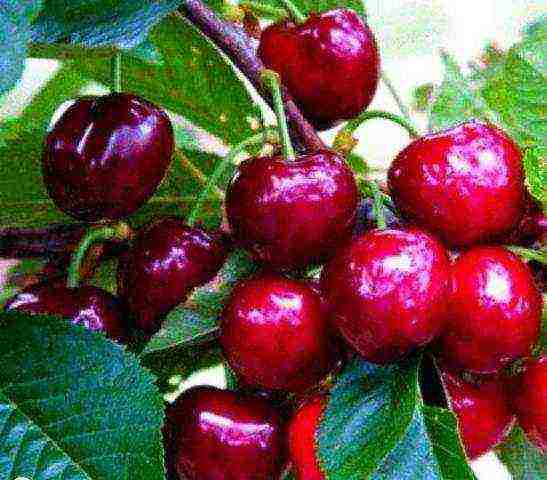
Sweetheart cherry is one of the most popular varieties in North America among professional farmers.
The berries are large, weighing 10–13 g, heart-shaped, but noticeably elongated vertically. The skin is blood-red. The pulp is very sweet, juicy, so tough that it almost crunches. The fruits do not crack even in very rainy weather. Productivity - more than 60 kg per tree.
Bigarro Burlat
An early French sweet cherry variety, known since the beginning of the last century. It is considered the result of natural selection, the "parents" have not been established. The tree is 3–3.5 m high, the crown is in the form of an almost regular ball, thickened. Brownish shoots are dotted with often spaced whitish "lenticels".
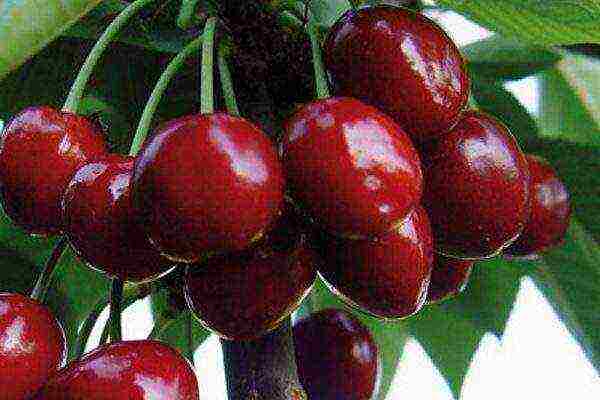
It is not yet possible to trace the "pedigree" of the Bigarro Burlat cherry variety
Fruits are medium-sized, weighing 5–6.5 g, slightly flattened in shape. The lateral "seam" stands out clearly. The skin is almost black, the flesh is dark scarlet. The stone is rather large and can be easily separated from it. The berries are tried for the first time 4–5 years after the tree has been planted. In the future, the average yield is 75–80 kg.
Winter hardiness at the level of -20 ° C, this applies to both wood and flower buds. Immunity to pathogenic fungi is good, but it can be better. In cool rainy weather, the fruit tends to crack. The variety is partially self-fertile, in order to increase yields, Exhibition, Napoleon black, Bigarro Starking are planted nearby.
Staccato
Late self-fertile variety of Canadian selection. Ripens in the second decade of August, one of the very last. Natural mutation resulting from free pollination of Sweetheart cherries.
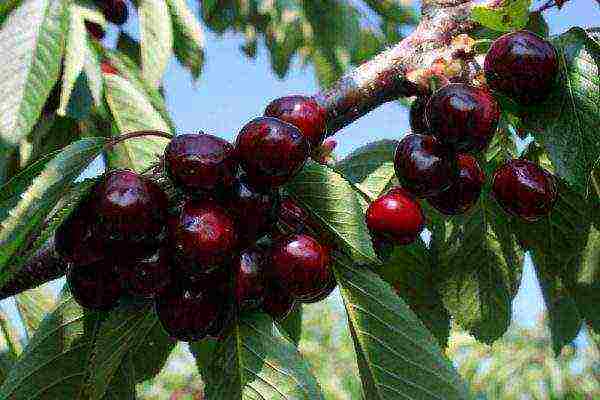
Cherry Staccato is prized by gardeners for its unpretentious care
The berries are large, maroon, weighing 11–12 g, slightly flattened in shape. The skin is firm but thin. The pulp is juicy, very sweet. The taste is rated at 4.8 points out of five. The first time a tree bears fruit is 3-4 years after planting.
Winter hardiness at the level of -25 ° C. The variety is distinguished by undemanding care, the ability to adapt to a wide range of not always favorable climatic and weather conditions, and good immunity.
Thanks to the achievements of modern breeding, sweet cherries are now successfully cultivated in areas with a temperate climate, and the berries are not much inferior in taste to the southern ones. Self-fertile varieties have a number of significant advantages over other varieties. Of course, most of them are not devoid of individual shortcomings, but more often than not they do not spoil the overall picture.
27 years old, higher education in law, broad outlook and interest in a variety of topics. Rate the article:
(2 votes, average: 5 out of 5)

Let's talk about cherries and describe the best varieties of it. There are sweet, slightly sour, crispy, soft, different colors. Thanks to selection, every year new forms of this amazing tree are bred.
Cherry varieties: description and photo
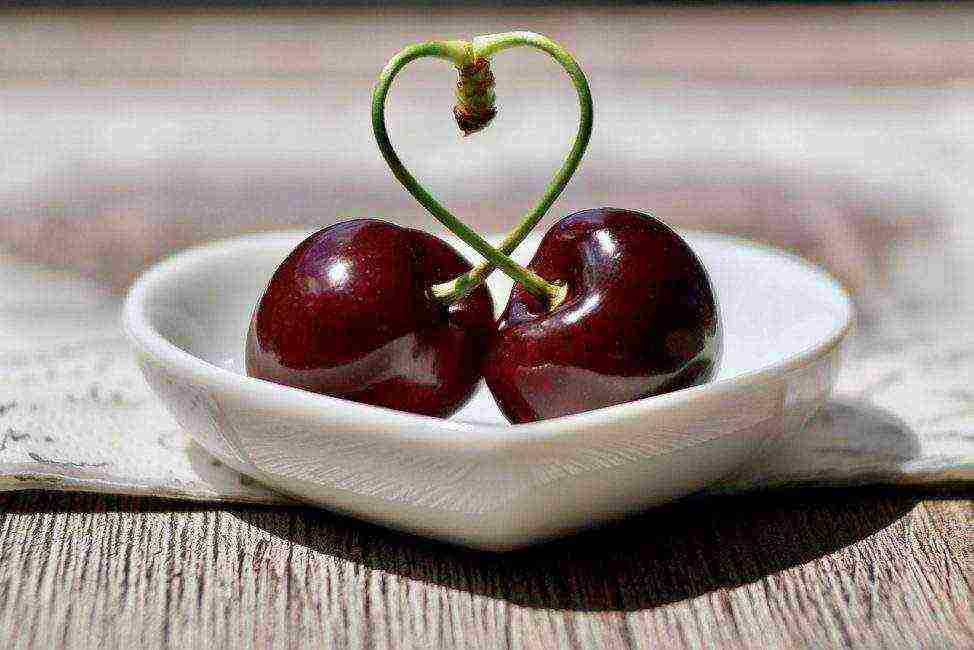
To get a bountiful harvest, it is necessary to choose varieties taking into account the peculiarities of the climate in a particular region. So, frost-resistant varieties are suitable for central Russia, and more thermophilic plants can be grown in Ukraine.
Unlike cherry, sweet cherry ripens much earlier, its tasty and aromatic fruits can already be enjoyed in early summer - June. It is a real source of useful trace elements (iron, iodine, potassium, magnesium, calcium) The fruits of the plant grow in the form of a single-celled drupe with a juicy pericarp.
Taking into account the late period of emergence of cherry fruit buds from the state of forced dormancy, the yield of this crop is characterized as stable. Another advantage of cherries is the presence of reliable protection from return frost in anthers and pistils, which is not the case with cherries.
The leaves of the fruit crop are very large in size, they are distinguished by an elongated-oval or elongated-obovate shape and brown glands on the petioles.
Most of the cherry varieties require additional pollination. Therefore, when choosing a tree, it is recommended to study its description, which indicates the necessary pollinators.
It is not so often possible to find self-fertile varieties on the market. They can be purchased by order from abroad. Among the popular hybrid forms, there are: Alex, Peter, Stella, Sandor, Sweet Hart.
Below is a list of the most popular cherry varieties with descriptions and photos.
Iput
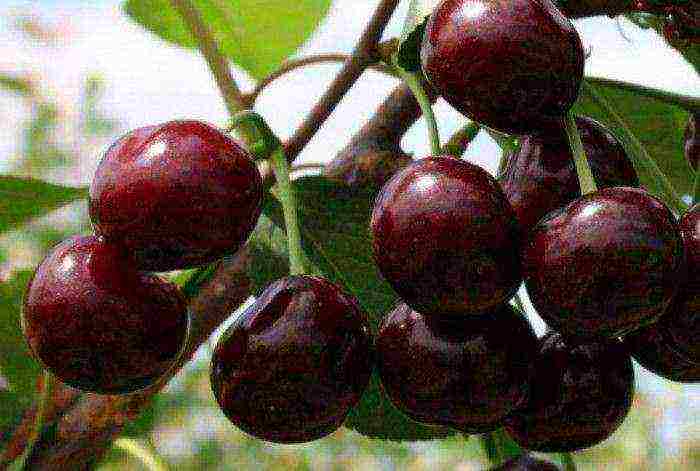
Read also:Everything about planting and growing cherries - from choosing a seedling to harvesting (Photo & Video) + Reviews
PROS:
- Average height
- Early ripening of fruits
- High yield (up to 30 kg of berries are removed from one tree)
- High palatability (fruits have black color and dark red juicy pulp)
- The berry is removed with the stalk
- The crop is not afraid of transportation
- High degree of resistance to fungal infections
- It tolerates low temperatures well (up to -28 degrees)
MINUSES:
- Average early maturity (yields a harvest 5 years after planting)
- With an excess of moisture, the fruits crack
- The pulp is difficult to separate from the bone
According to reviews:
It is recommended to plant it in pairs together with Revna, since these varieties are inter-pollinated. It turned out to be very tasty, large, the first harvest is already 3 years old. It grows quickly, almost one-meter increments per year. turned out to be not dark red, but just red, maybe because of the lack of the sun.
Valery Chkalov

PROS:
- Early ripening of berries
- Large fruit size (weight up to 6-8 g)
- High taste characteristics of fruits (the pulp is dark red in color, juicy, semi-gristly consistency)
- Dessert type
- Universal use of berries
- High level of productivity (62 kg per tree on average)
- High level of frost resistance (-23.5 degrees
MINUSES:
- Height (up to 5 m)
- Wet separation of the berry from the stalk, juice is released
- The level of early maturity is medium (yields a harvest for 5 years)
- Self-infertile variety
- Average level of resistance to diseases, including fungal
Pollinators: Dnieper, Bigarro Burlat, April, June early Skorospelka
Jealous
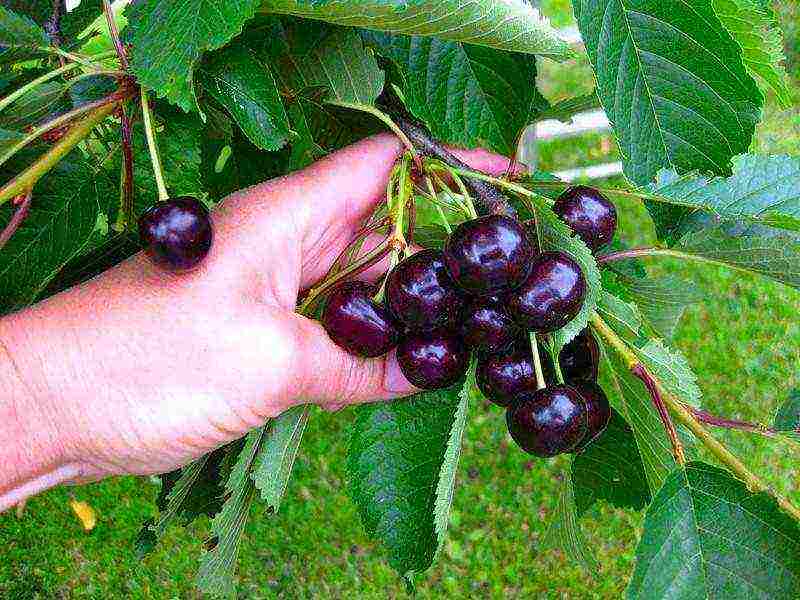
Read also:Cherries: what you need to know about them in order to get generous harvests. Description, planting and care (25 Photos & Videos) + Reviews
PROS:
- Medium-sized tree, compact
- The crown has no sharp forks
- Unpretentious in care
- Fruits are distinguished by high taste and consumer qualities.
- Due to the dense skin, the crop is transportable over long distances
- High level of frost resistance (up to -30 degrees)
- High resistance to frost crack, sunburn
- Resistance of the tree to fungal infections
MINUSES:
- Medium late harvest ripening
- Self-infertility
Its best pollinators: Raditsy, Compact, Iput, Venyaminova, Tyutchevka, Ovstuzhenki
Large-fruited
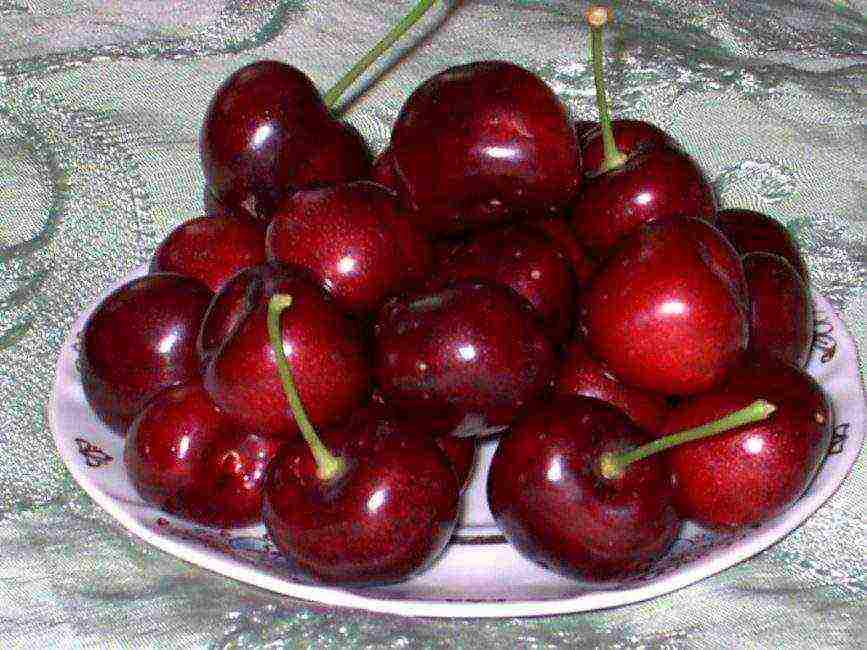
PROS:
- Medium-sized tree
- Fruits are very large in size, their weight is up to 18 g
- Sweet and sour taste, dark red fruit color, medium density pulp
- High product characteristics
- Increased frost resistance
- Dry detachment of the peduncle
- Good transportability
- Not susceptible to moniliosis
- Drought tolerance, no loss of crop flavor
MINUSES:
- Late ripening
- Self-sterile
Top pollinators: Bugaro Oratovsky, Surprise, Francis,
Vasilisa
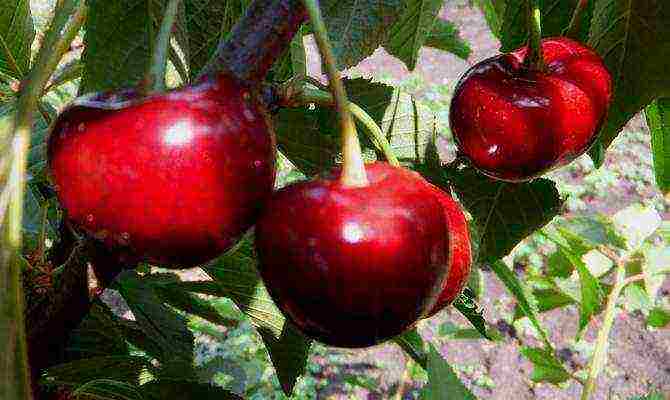
PROS:
- Mid-season
- Very large berries, weighing up to 15 g
- Taste and commercial qualities are excellent (the fruits have a rich red color, glossy shine, the pulp is dense, fleshy, juicy)
- Tasting score 4.5 points
- Duration of fruiting 20 years
MINUSES:
- Berries with heavy precipitation are subject to shedding
- Requires additional pollination
- Low resistance to fungal diseases and garden pests
Top pollinators: Early ripening, Burlat, April, Household, Early Bigarro
Ovstuzhenka
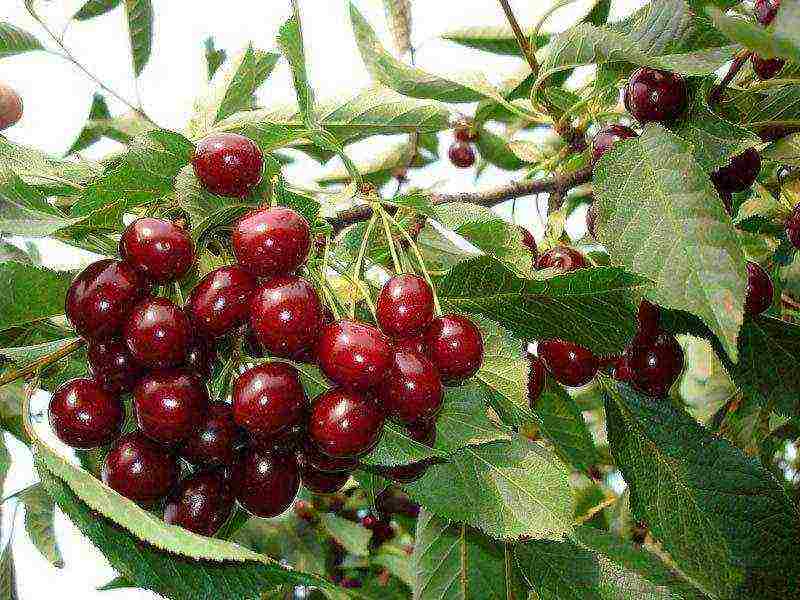
PROS:
- Early ripening of the crop
- It does not require special care
- Medium-sized tree, with a rapid growth rate
- Large berries, weight up to 7 g
- The pulp is sweet enough, juicy
- The color of the berries is dark burgundy
- Product and taste characteristics are high
- Disease resistance is good
- High frost resistance
MINUSES:
- Average yield, on average 15 kg per tree
Regina
PROS:
- Late-ripening variety
- The size of the tree is medium, the growth is gradual
- Does not create difficulties in care and harvesting
- High indicator of presentation and taste
- Berries are not afraid of transportation
- The structure of the berries is firm, the pulp is tasty and aromatic
- The size of the fruits is large, their weight reaches 10 g
- The level of frost resistance is sufficient
- Disease resistance to garden pests is excellent
MINUSES:
- Low rate of resistance to viral diseases
- Requires additional pollination
Pollinators: Karina, Bianca, Sylvia, Nephris, Coral Lotivka
Bull heart
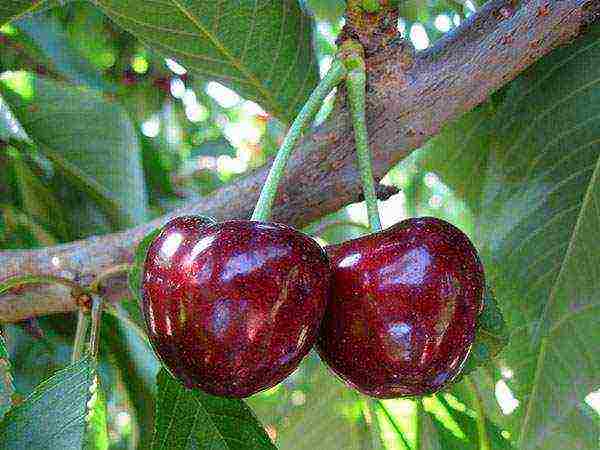
PROS:
- Large-fruited, average berry size 8 g
- The color of the fruit is dark burgundy, the pulp is of medium density, the skin is moderately dense with a smooth surface
- Type of separation from the stalk dry
- Universal purpose of fruits
- High degree of productivity
- The size of the tree is medium, but there are also tall plants.
- The degree of frost resistance is good, up to - 25 degrees
- Not susceptible to coccomycosis
MINUSES:
- Low transport rate despite dense skin
- Berries have a short shelf life, processing is required as soon as possible
- Self-infertile variety
Top pollinators: Tyutchevka, Iput, Ovstuzhenka
Yellow

PROS:
- Late ripening of berries
- Increased winter hardiness
- Excellent taste (the pulp is amber, dense structure, juiciness and pronounced aroma)
MINUSES:
- The degree of transportability is low
- The pulp does not separate well from the bone
- Additional pollination required
- Exposed to the invasion of the cherry fly
Pollinators: Bagration, Napoleon pink. Denissena yellow, Cassini early
Early pink
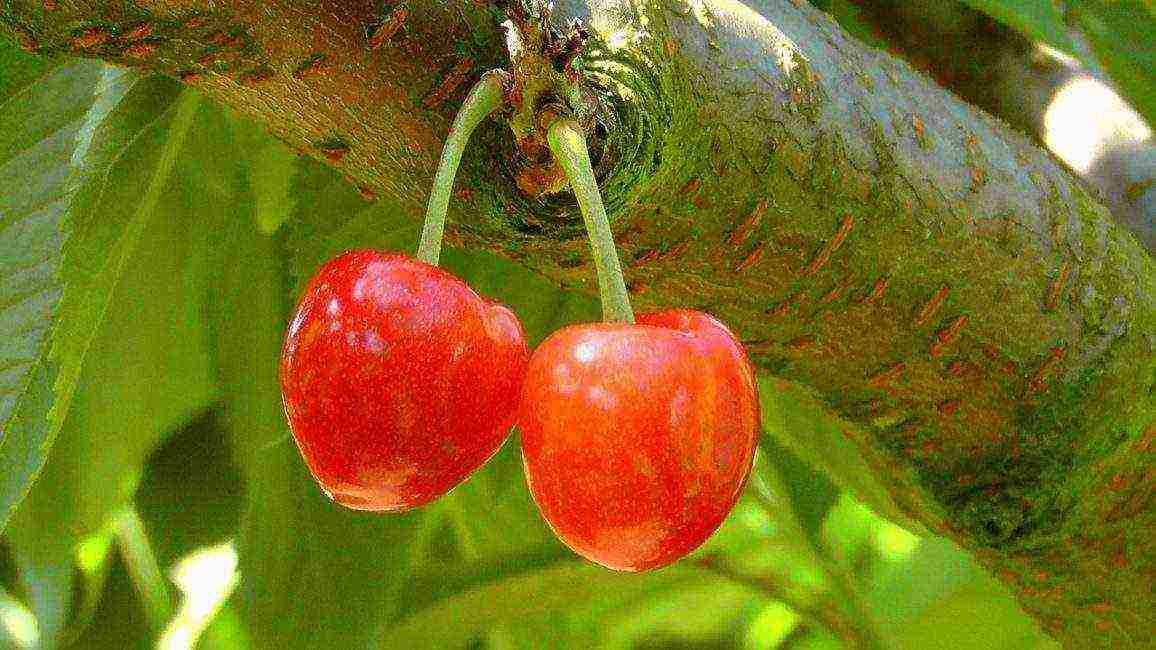
PROS:
- Early ripeness of fruits
- Taste characteristics are high (the pulp is distinguished by a creamy color, the structure is medium-dense, the juice is transparent)
- High resistance to low temperatures
- A fairly good level of resistance to monoliosis, coccomycosis
- Dessert type of berries
- High yield rate, up to 40 kg per tree on average
MINUSES:
- Berries are medium in size, their weight reaches an average of 5 g
- Trees grow up to 5 m
- Low rate of crop transportability
- Poor keeping quality of berries, processing is required in a short time after full ripening
Fatezh
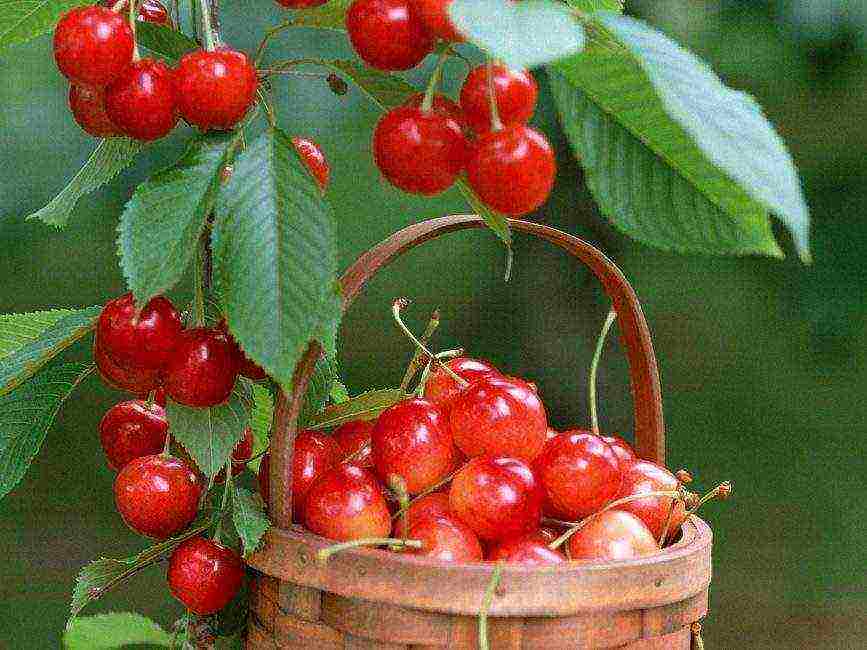
PROS:
- Large-fruited, their average weight is 4.5 g, maximum 6 g
- Fruit tasting score 4.7 points
- The pulp separates easily from the bone
- Fruiting begins at 3-4 years of life of the tree
- The yield indicator reaches 50 kg per tree per season
- The level of winter hardiness is high -30 degrees
- Not susceptible to fungal infections, coccomycosis, moniliosis
- Berries are not afraid of long distance transportation
MINUSES:
- Additional pollination required
Recommended pollinators: Chermashnaya, Iput, Revna, Crimean, Raditsa.
Leningrad black
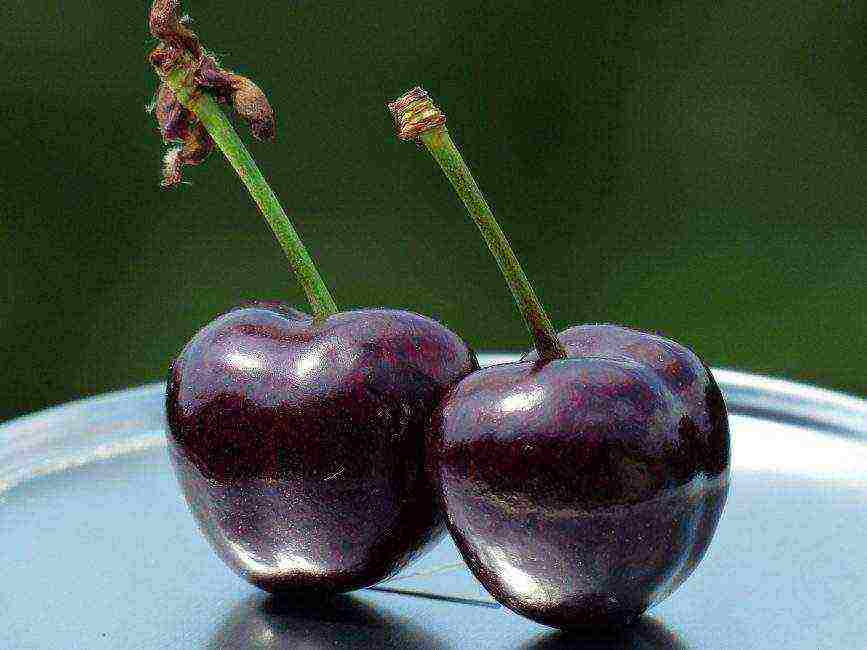
PROS:
- The variety is medium-sized, the crown is spreading
- The first crop can be harvested in the third year after planting in a permanent place, in June
- Tasting assessment of the harvest 4.2 points
- The taste and market characteristics are high (the average weight of berries is 5 g, the color is dark burgundy, the pulp is sweet, juicy, there is a slight bitterness)
- The purpose of the fruits is universal, excellent for fresh consumption, and for compotes, jam
- High rate of resistance to garden pests and various diseases
- The variety is unpretentious in care
- The increased degree of frost resistance, withstands low temperatures up to -30 degrees
MINUSES:
- Self-fertile variety
- Additional pollination required
Pollinators required: Leningrad yellow, Leningrad pink, Red dense, Fatezh Berries are prone to cracking, with excessive moisture.
Dybera black
PROS:
- High level of productivity, most often up to 90 kg of tasty and aromatic berries are removed from trees, but under favorable conditions, 170 kg of harvest can be removed from one tree
- Fruits are large in size, their average weight is 6 g
- The pulp is of medium density, juiciness, dark burgundy color, there is a slight sourness
- The frost resistance index is quite high, up to -30 degrees
MINUSES:
- Poor resistance to negative temperatures
- Mature trees reach a height of almost 6 m, which makes them difficult to care for and harvest
- The tree begins to bear fruit 5 years after planting in a permanent place
- Requires additional pollination
- Insufficient immunity to various types of diseases, including fungal, to garden pests
- Regular pruning of the crown is required
Recommended pollinators: Drogana yellow, Bull heart, Napoleon pink, Fatezh,
Cordia
PROS:
- "Queen" of late varieties
- Universal fruits
- Taste and commercial characteristics are high
- Berries are large enough, their weight can reach 8-10 g
- Color carmine black, skin tone bronze
- Fruits are not prone to cracking, do not rot
- Excellent long-distance transportation
- When grown on vigorous rootstocks, the variety is characterized by rapid growth.
- Productivity is regular, fairly high
MINUSES:
- The variety is self-fertile, additional pollination is required
- There is a need for short pruning, the growth of shoots is significantly enhanced
- Average winter hardiness
- The crop is moderately resistant to cracking
Top pollinators: Van, Summit, Karina, Regina, Burlat.
Tyutchevka
PROS:
- Medium late harvest ripening
- Medium-sized tree, semi-spreading crown, sparse, spherical
- The beginning of the fruiting period falls on 3-4 years of plant life.
- The berries are medium in size, their weight is 5-6 g, but under favorable growing conditions they can reach 7 g
- Taste and commercial characteristics are excellent (the color of the pulp is dark red, the structure is dense, the aroma is pronounced)
- Tasting assessment of the harvest 4.9 points
- The crop is not afraid of transportation over long distances, the keeping quality of the fruits is good
- Resistance to major diseases is good
- The average productivity index is over 97 c / ha, with proper agricultural technology this indicator can reach 275 c / ha
- High level of resistance to moniliosis
MINUSES:
- Low self-pollination rate, up to 6%
- Average degree of resistance to clasterosporium disease, coccomycosis
Top pollinators: Iput, Raditsa, Revna, Ovstuzhenka
General's
PROS:
- Variety with medium-late ripening of berries
- The size of the fruits is large enough, their weight is 9-12 g
- The color is yellow, there is a carmine blush
- The pulp stands out with a sweet and sour taste, dense structure, very juicy
- Tasting score - 4.6 points
- The indicator of drought resistance and frost resistance is very high
- Fruiting begins 3 years after planting in a permanent place
- Unpretentiousness when growing
- Resistance to typical diseases and garden pests is sufficient
MINUSES:
- Fruits cannot retain their taste and marketability for a long time, they do not tolerate long-distance transportation
Pollinators: Tyutchevka, Ovstuzhenka, Iput, Crimean, Lapins
Italian
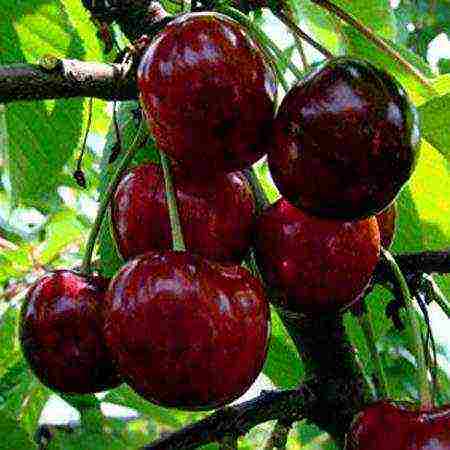
PROS:
- Self-fertile variety
- Fruits ripen early
- Taste and marketable qualities are excellent (the color of the berries is deep red, the pulp is moderately dense, tender, fleshy, it separates well from the stone)
- Large fruits, weight up to 6 g
- High productivity index
- Resistance to major diseases and garden pests is high
- Good frost resistance, up to - 28 degrees
MINUSES:
- There are no obvious shortcomings, based on the reviews of gardeners
Bakhor
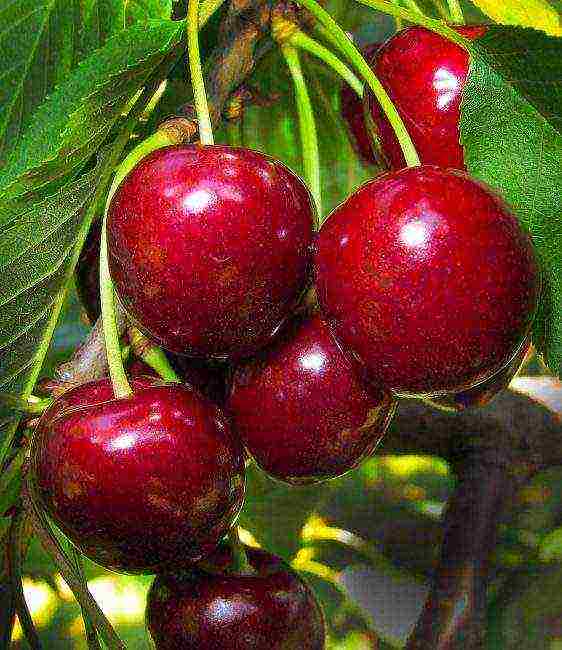
PROS:
- The crop ripens early, in the first - in the second decade of May
- The tree grows very quickly, the degree of leafiness is medium, the crown is round
- Fruiting period begins in the fourth year after planting in a permanent place.
- The size of the fruits is quite large, 8-9 g, their color is dark red, wide-heart shaped
- The color of the pulp is dark red, the structure is medium density, very juicy, it has a sweet taste, there is a slight sourness
- The pulp separates well from the stone
- Due to the dense skin, the crop is not afraid of transportation over long distances, it retains its presentation for a long time
- The fruits can be used both for fresh use and for compotes, jams, preserves.
- Tasting score 5 points
- Dessert type harvest
- Planting material is grown from seedlings
- The indicator of resistance to fungal diseases is good
- Frost resistance is sufficient, up to - 25 degrees
MINUSES:
- Vigorous, height 5-6 m
- The yield indicator is average, up to 45 kg of fruits can be removed from one tree
Farewell
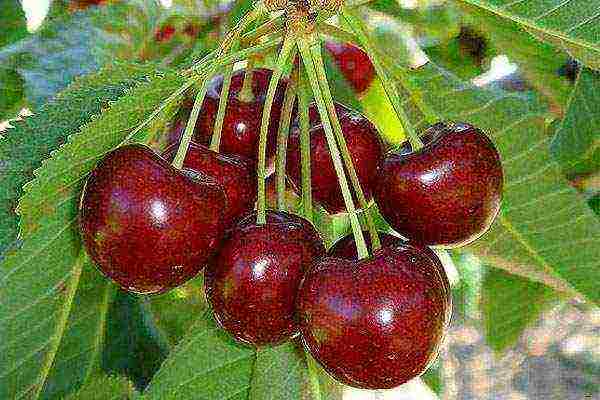
PROS:
- Cherries with early ripening, are very popular among gardeners and consumers.
- It is appreciated for its unpretentious care.
- Excellent taste of fruits, large-fruited, high rate of drought and winter hardiness
- High yield rate, up to 95 kg of harvest is removed from one tree
- Fruits are excellent for fresh use, for winter harvesting
- The size of the berries is large enough, weight up to 13 g
- The color is red, the color of the flesh is yellow
- The taste is sweet, harmonious, the aroma is pronounced, there is a wine-sweet aftertaste
- The pulp is easily separated from the bone
- The tasting score is 4.5 points
- The variety is distinguished by its early maturity
- The yield is high, after 10 years the figure is about 100 kg
- Thanks to the dense skin that protects the pulp well, the crop can be stored for a long time and is not afraid of transportation over long distances
- High degree of resistance to coccomycosis
- Increased degree of frost resistance
MINUSES:
- The tree is very vigorous, which makes it difficult to pick berries
- The variety is self-fertile, additional pollination is required.
- Average indicator of resistance to fungal infections
Pollinator varieties: Donetsk coal, Valery Chkalov, Donetsk beauty, Sister, Valeria, Donetsk Yaroslavna, Ethics, Rannnya rovinka, Aelita, Annushka, Donchanka
Yaroslavna
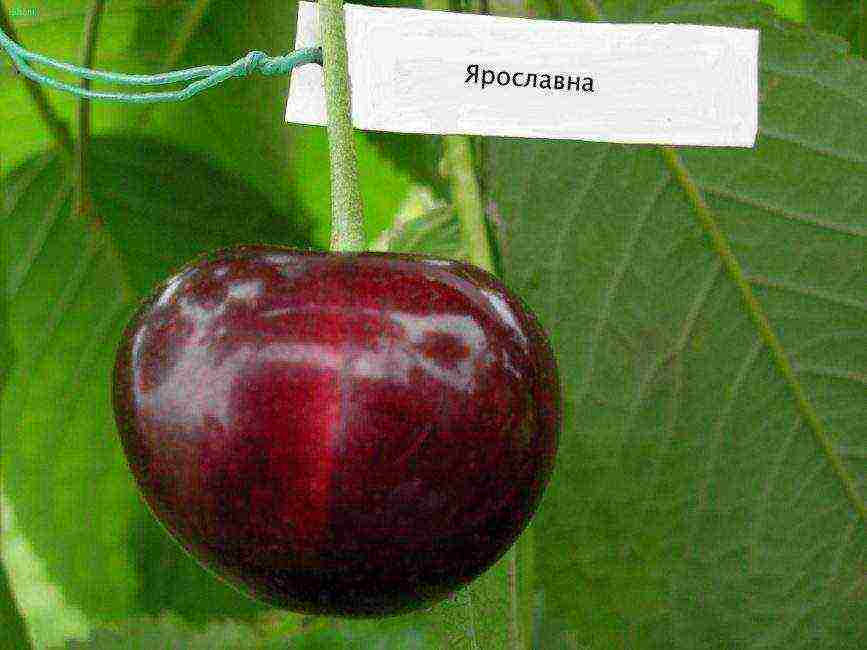
PROS:
- The tree is medium-sized, its height does not exceed 3.5 m
- Does not require special conditions for growing, care
- The yield indicator is high, annual
- Type of separation from the stalk dry
- Taste and marketable qualities are excellent
- Fruit size is large, weight is 8-9 g
- The pulp is very sweet, pleasant, of medium density, red in color
- The color of the cherry pomegranate is red, the stone is small in size, it separates well
- The increased degree of frost resistance, drought resistance, resistance to coccomycosis
- Berries do not crack in high humidity conditions
- Transportability is good
MINUSES:
- The variety is vigorous, the crown is spherical - spreading, the branches are curved
- Additional pollination required
- Average indicator of resistance to fungal infections
Pollinators: Ovstuzhenka, Raditsa, Iput, Chermashnaya, Fatezh.
7.5 Overall Score
After reviewing the description of cherry varieties, having studied their strengths and weaknesses, you can choose the most suitable option for your personal plot. It is recommended to purchase seedlings in specialized retail outlets, while you need to pay attention to the presence of damage on the trunk and root system. We tried to collect for you the most popular varieties of cherries and give all the necessary information on them. If you disagree with these ratings, leave your rating in the comments with the reasons for your choice. thank you for your participation. Your opinion will be useful to other users.
Add your review | Read reviews and comments


